Understanding and Maximizing Your Pokémon's Stats:
A Complete Trainer's Guide
Are you interested in training your Pokémon to have the best stats, but you don't really understand how to do it? Perhaps you've watched videos or read articles about things like base stats and EVs, but you're still confused by all the similar-looking terms and numbers and colored charts. Pokémon stat mechanics are surprisingly complex - there's much more to learn than the games themselves teach you!
This plain-language guide aims to demystify the five variables that determine a Pokémon's stats: base stats, level, nature, IVs and EVs. Along the way I'll demonstrate how to train your Pokémon to give it the best stats it can possibly get! Every mechanic and training technique will be explained with plenty of screenshots to help you understand each section.
As our example, we'll train a Politoed. The same fundamental principles we'll discuss for Politoed also apply to any other Pokémon you'd like to raise, whether you're preparing for competitive battles or you just enjoy having top quality Pokémon. As you follow along with Politoed's training progress, I hope you'll gain familiarity with stat mechanics and learn how to make your own decisions about raising any Pokémon you like to its full potential.
Before you start training, take some time to consider your end goal. It's only possible for a Pokémon to maximize two of its stats, at most, so you should decide in advance what you'd like to train your Pokémon to actually do. Maybe you've already chosen which stats you want your Pokémon to specialize in; for example, you want an Incineroar with the highest possible Attack stat. Or maybe you aren't sure yet.
If you have a Pokémon you want to raise but you're not sure which stats would be best to raise, think about what you'd like to do with the Pokémon. Do you want this Pokémon to deal lots of damage with its attacks? Do you want to use it in Tera Raids? Do you want it to help you catch more Pokémon easily? Do you want to create a strategy based on a specific move, ability or theme? Do you want it to fulfill a specific team role?
Then, think about what stats would help your Pokémon accomplish those goals or perform well in that role. These ideas should guide you towards choosing how to raise your Pokémon.
Remember, there's no right or wrong answer! Pick whatever seems good to you. If you change your mind later, that's okay - you can always change your Pokémon's training again. Explore your creativity and have fun!
Base stats are the default stats set for each Pokémon species and form. In other words, they are the background numbers that define the parameters of every kind of Pokémon to make them different in battle. Base stats are the foundation numbers that say Jolteon have higher Speed than Slowpoke, Shuckle have great Defense but weak Attack, Haxorus are an upgrade from Axew. Without base stats, different Pokémon that share the same types, moves and abilities would all perform exactly the same in battle. Only their looks would be different.
Let's look at the base stats for Politoed. Click here to view the page on PokemonDB. We can see that by default, Politoed have high HP, Special Attack and Special Defense stats. Special Defense is their strongest stat overall. Their Attack, Defense and Speed stats are mediocre at best.
Next let's look at the individual Politoed we're going to raise. Here's her summary. Just caught at level 60, no training yet:
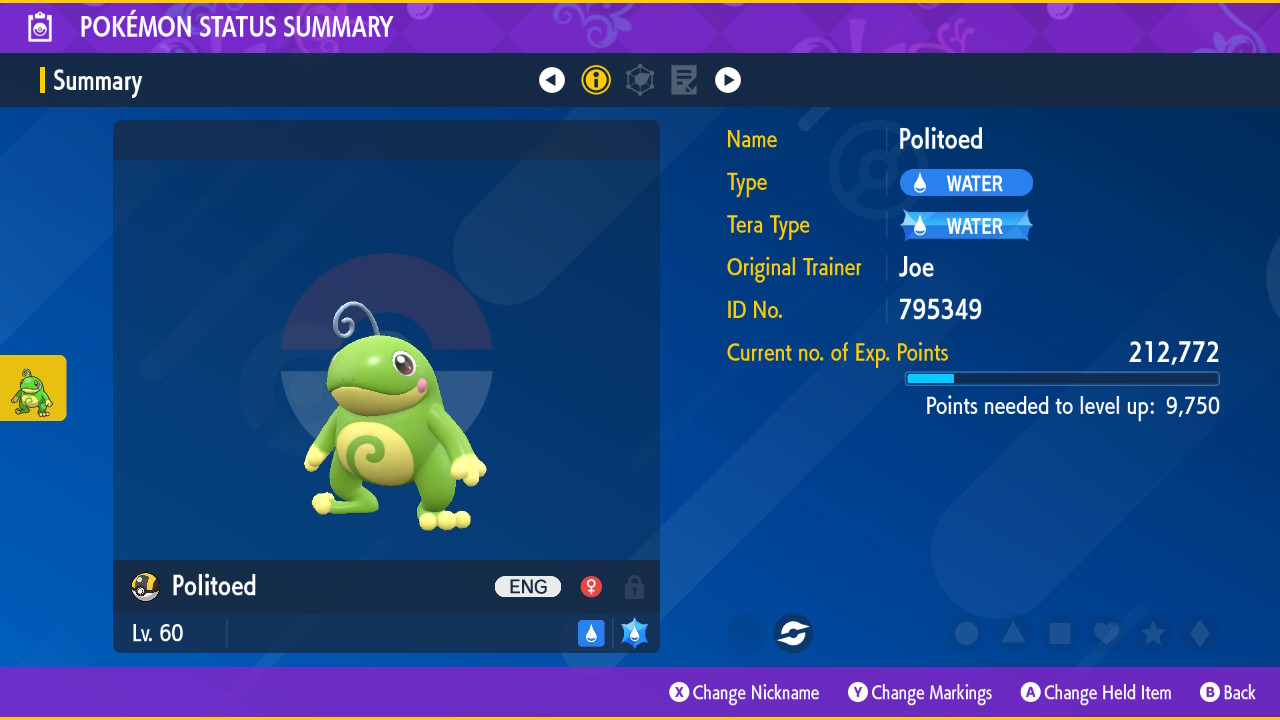
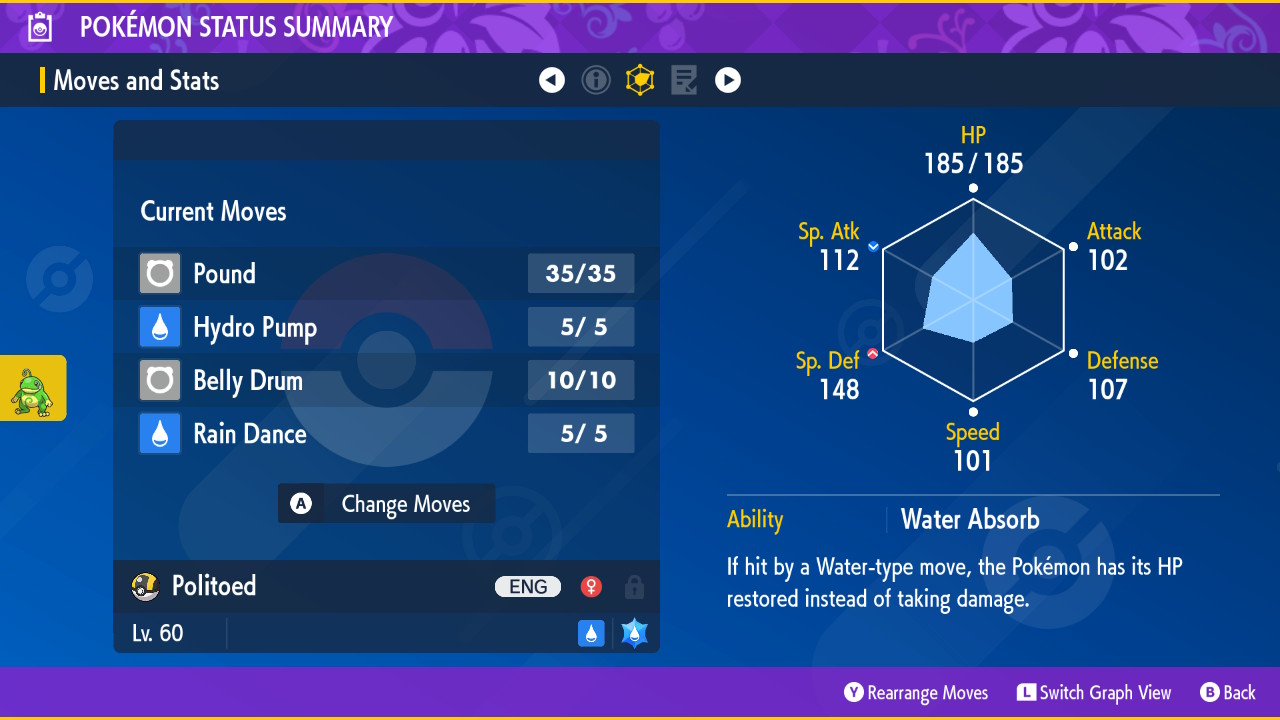
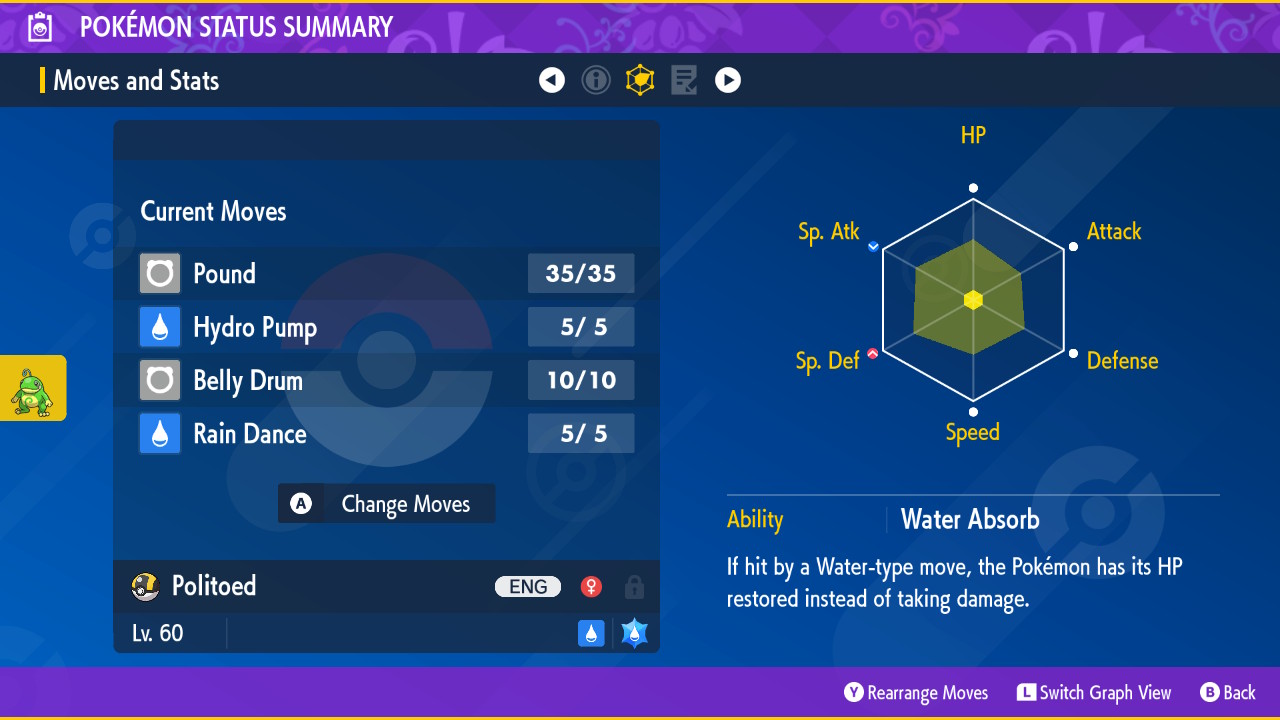
Our Politoed's stats - the HP, Attack, Defense, Special Attack, Special Defense, and Speed numbers we see in her stat summary - follow roughly the same pattern as the base stats shown on PokémonDB. Our Politoed starts with pretty good HP, Special Attack and Special Defense. Special Defense is her highest stat. In comparison, her Attack, Defense and Speed are much lower. Why aren't Politoed's stats exactly the same as the numbers we saw on PokémonDB? Because base stats don't directly correspond to the stats we see for individual Pokémon in-game. Base stats are only one component of a larger formula that calculates the stats for each individual Pokémon.
The information we've just discussed helps to answer the question: how should I raise our Politoed? Personally, I enjoy doing high level Tera Raids, so I'd like our new Politoed to be viable for raiding. Five+ star difficulty raids favor durability over offense, since you will often be unable to one-hit KO the bosses through their massive HP pools. Politoed should have solid defenses - especially Special Defense, since that's her best stat - so she can take plenty of hits. I'd also like her to do decent damage using Special Attack, but pure damage isn't gonna be her main focus.
So, we've got a plan! Let's maximize Politoed's HP and Special Defense.
A Pokémon's nature is more than flavor text! A Pokémon's nature increases one of its stats by 10% and reduces another by 10%, indicated by red (up) and blue (down) arrows shown on the Pokémon's stat chart. Each nature changes a different pair of stats.
Our Politoed has a careful nature.
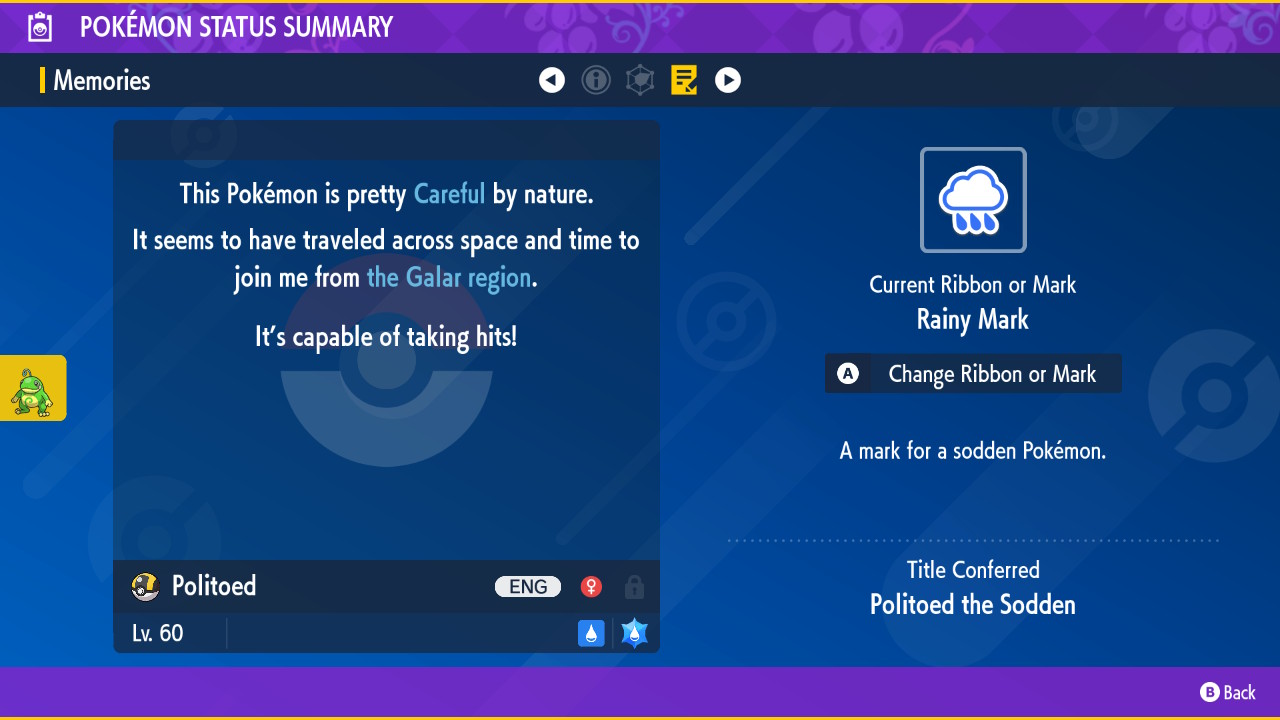
Careful nature increases the Special Defense stat and reduces the Special Attack stat. See the little up and down arrows?

Politoed's nature penalty to Special Attack is not ideal. Her Special Attack stat is being reduced by 10%, but we'd prefer her special attacks to hit as hard as possible. Fortunately, there's an easy solution to fix this problem.
Mints are consumable items that adjust the effect of a Pokémon's nature. When you use a mint, your Pokémon's current nature bonus and penalty will change to the ones that match the nature indicated by the mint. The text description shown in your Pokémon's summary does not change, but its stats do - exactly as though your Pokémon had a different nature from the beginning. There is absolutely no difference between an original nature and a minted nature, so there's no downside to using mints! And the effect is permanent until you feed your Pokémon another mint, which you can do as many times as you'd like to adjust its stats. Mints are sold at the Chansey Supply Shops in Mesagoza, Montenevera, and Cascarrafa.
Let's use a Calm Mint on Politoed. Calm nature increases Special Defense and reduces Attack. This is shown in the item's in-game text description.
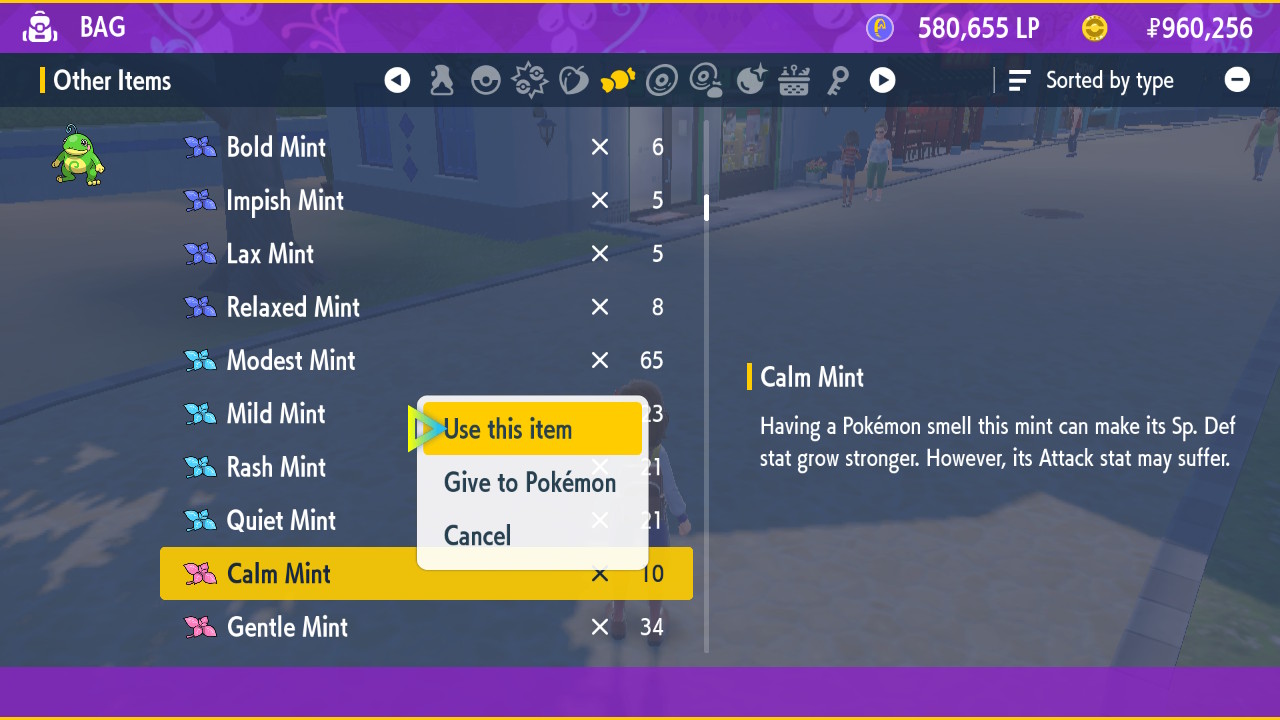
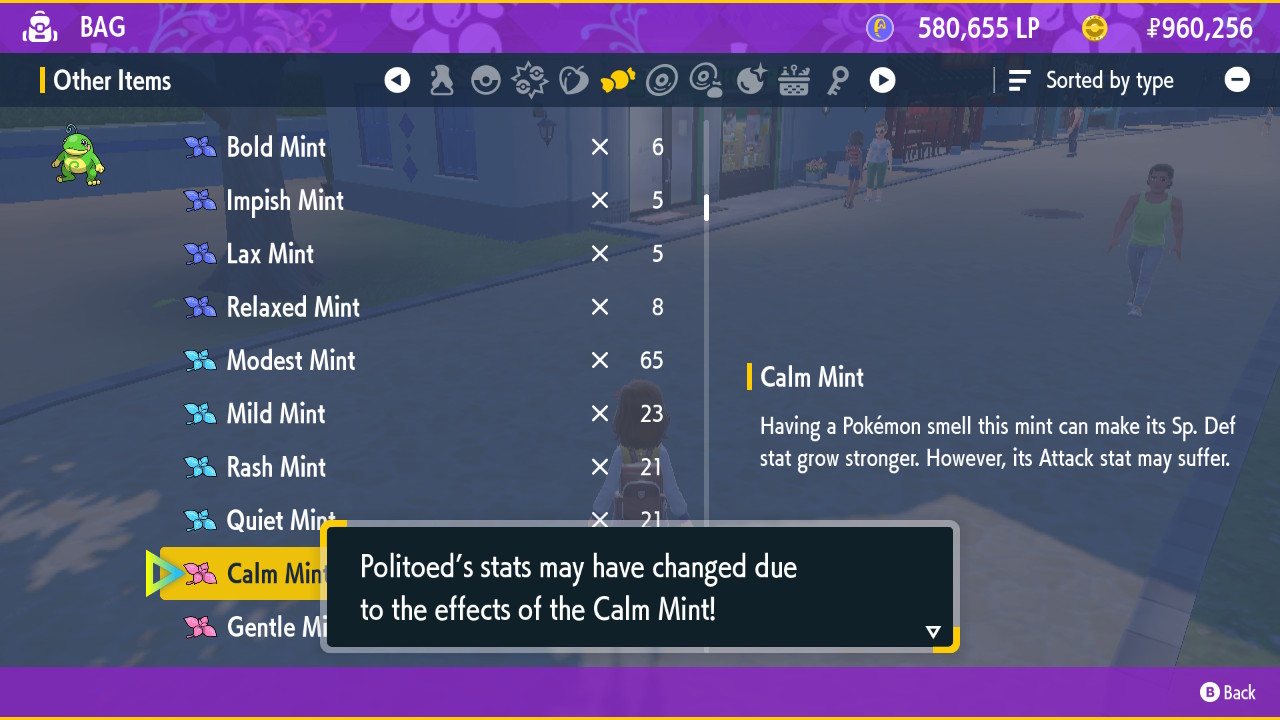
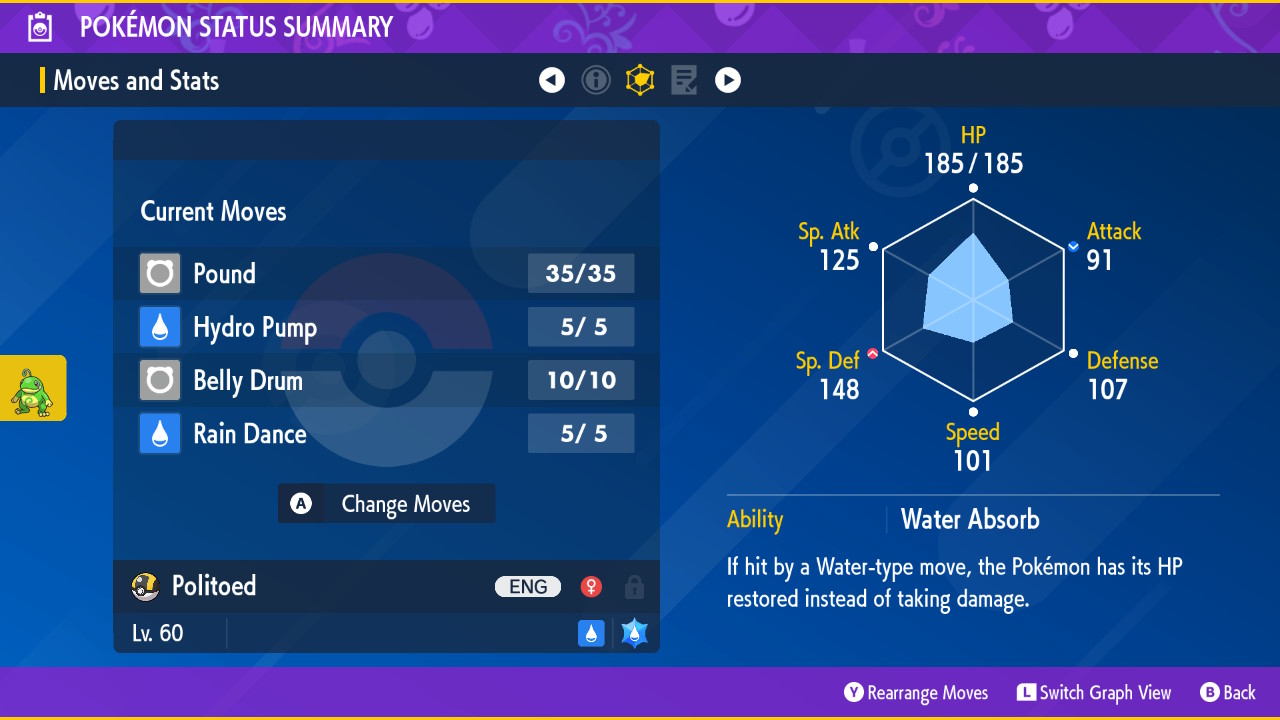
Here's how Politoed's stats changed: Attack decreased from 102 to 91 (-11). Special Attack increased from 112 to 125 (+13).
Politoed still officially has a careful nature, but now the effect of her nature is more beneficial. The Calm Mint increased Politoed's Special Attack by removing the penalty from it, and she kept the same Special Defense bonus she already had. In exchange, Politoed's Attack decreased; Attack has the penalty now. She'll deal less damage with physical attacks from now on, but that's a tradeoff I'm happy to make.
Effort values (EVs, also confusingly known as base strengths) are one of the sets of unique values that make specific individual Pokémon different from others of the same species. The EV system allows you to customize your Pokémon's stat allocation. The values are called 'effort' because they represent the concept of a Pokémon training to become better/more skilled at using particular stats. You could also think of EVs as "expertise," "talent points" or "stat experience." For example, Defense EVs are like your Pokémon has learned how to guard itself better against physical attacks, improving its Defense stat.
Using the stat experience analogy, imagine that in addition to your Pokémon's regular experience bar, your Pokémon also has six invisible 'stat experience' bars, one for each of its stats. As you train your Pokémon, it gains 'stat experience points' that fill up those hidden bars. When your Pokémon's stat gains enough 'exp,' that stat invisibly 'levels up' and your Pokémon gets an increase to the total stat value you see displayed in your Pokémon's stat summary.
EV training (also known as super training) means the process of making your Pokémon gain specific amounts of EV points to intentionally raise its stats by pre-planned amounts. Usually people EV train for competitive battles, where trainers' strategies often require their Pokémon to achieve particular stat numbers. However, you can successfully EV train even if you don't care about the math behind how it works. In fact, you may be interested in my EV Training Planner! If you're following this guide with your own Pokémon, why not give it a try?
Feel free to skip to the next paragraph, but here we go with a more detailed look into the mechanics of EVs. A Pokémon can gain a total of 510 EV points spread across all six of its stats. Each individual stat can gain up to 252 EV points; 252 is the maximum amount of EV points possible for a single stat. At that point the stat has basically reached the 'stat level cap' and that Pokémon gets the highest possible bonus for the relevant stat. The actual impact of EVs on stats is scaled with the Pokémon's level and nature. In general, it takes 4 'stat exp' points for each 'stat level up'. (4 EV points = +1 stat point at lvl 100.)
Okay, math class is over! The important fact going forward is that 252 EV points in a stat = the highest possible stat gain.
A basic and popular spread to EV train is 252/252/6: that's two stats raised the maximum amount, and a tiny boost to a third stat. I'll demonstrate this EV spread with Politoed, enhancing her three strongest base stats: 252 HP, 252 Special Defense, and 6 Special Attack.
Vitamins, Mochi and Feathers are consumable items used to instantly gain EV points, like rare candy for specific stats. EV training with consumables is super fast and easy; the only downside is that you may need to spend time farming the items.
| Consumables for Gaining EV Points | |
|---|---|
| Item | Effect |
| HP Up / Health Mochi | +10 HP EVs |
| Health Feather | +1 HP EV |
| Protein / Power Mochi | +10 Attack EVs |
| Muscle Feather | +1 Attack EV |
| Iron / Resist Mochi | +10 Defense EVs |
| Resist Feather | +1 Defense EV |
| Calcium / Genius Mochi | +10 Special Attack EVs |
| Genius Feather | +1 Special Attack EV |
| Zinc / Clever Mochi | +10 Special Defense EVs |
| Clever Feather | +1 Special Defense EV |
| Carbos / Swift Mochi | +10 Speed EVs |
| Swift Feather | +1 Speed EV |
We want Politoed to have 252 HP points. So, for example, we can feed Politoed 25 HP Ups/Health Mochi plus two Health Feathers, equaling exactly 252. Or we could use 26 HP Ups - that actually adds up to 260, but since the maximum limit is 252 per stat, it'll cap out at 252. Or we could use 252 Health Feathers. Or whatever! Any combination of EV training items will work as long as they add up to the desired final EV.
Let's go ahead and use 26 HP Ups on Politoed:

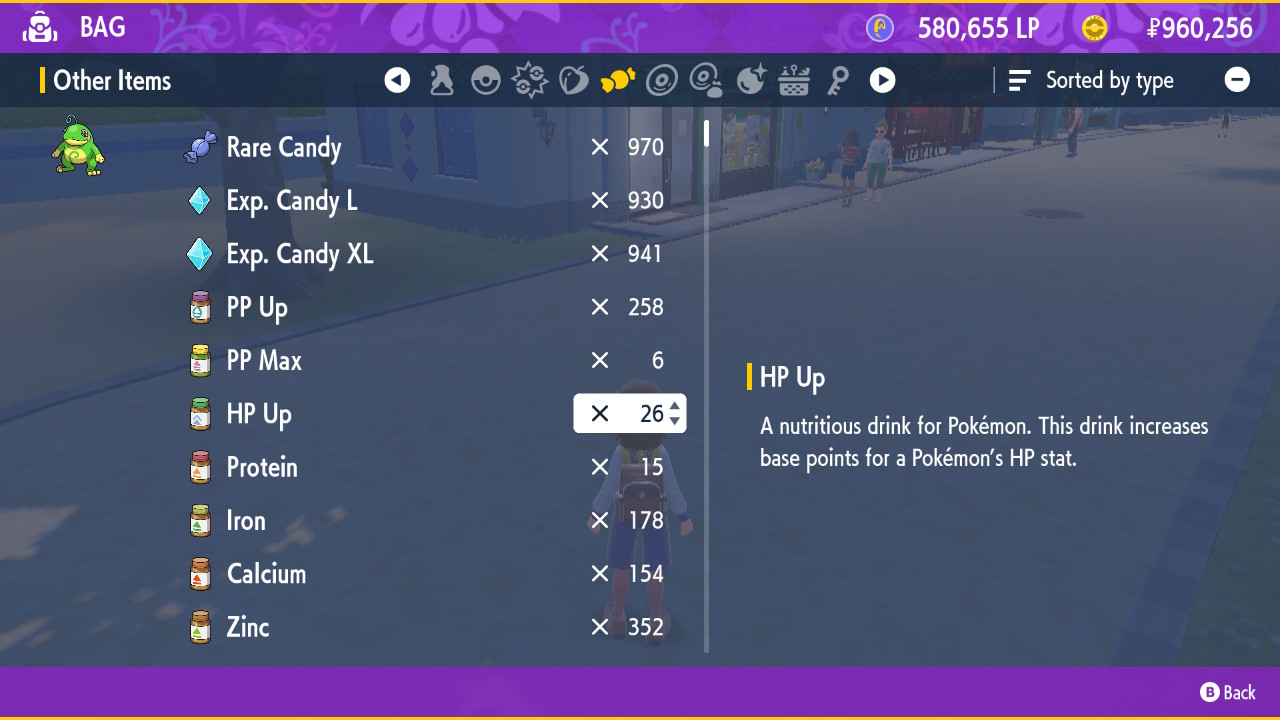
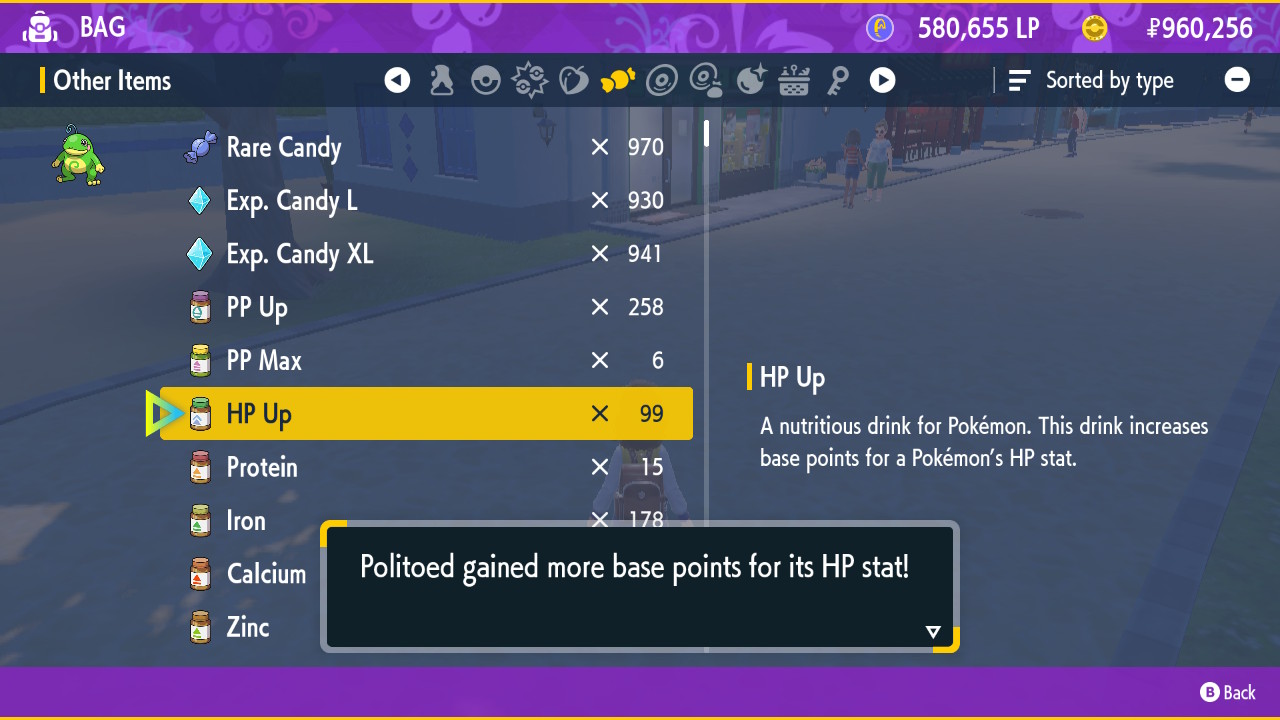
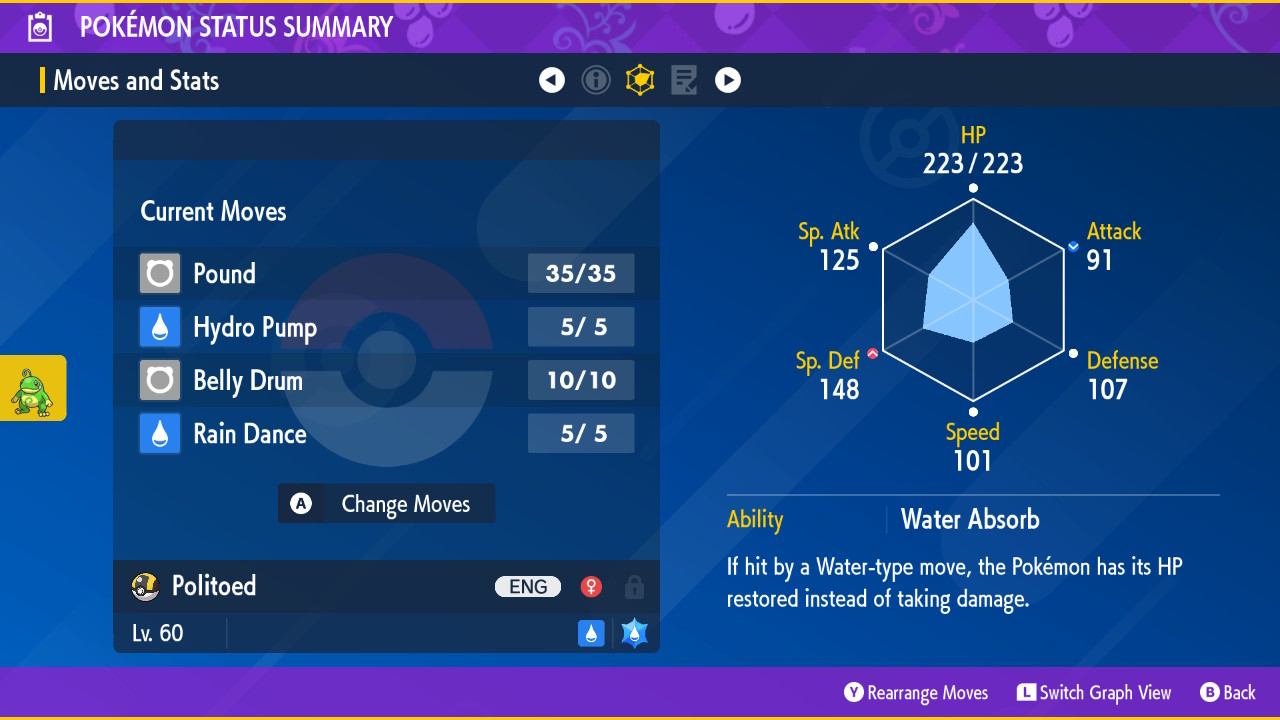
Here's how Politoed's stats changed: HP increased from 185 to 223 (+38).
Politoed's HP EVs are maxed out. To indicate this, you will see a sparkle effect on HP on the EV chart in the Pokémon's stat summary.
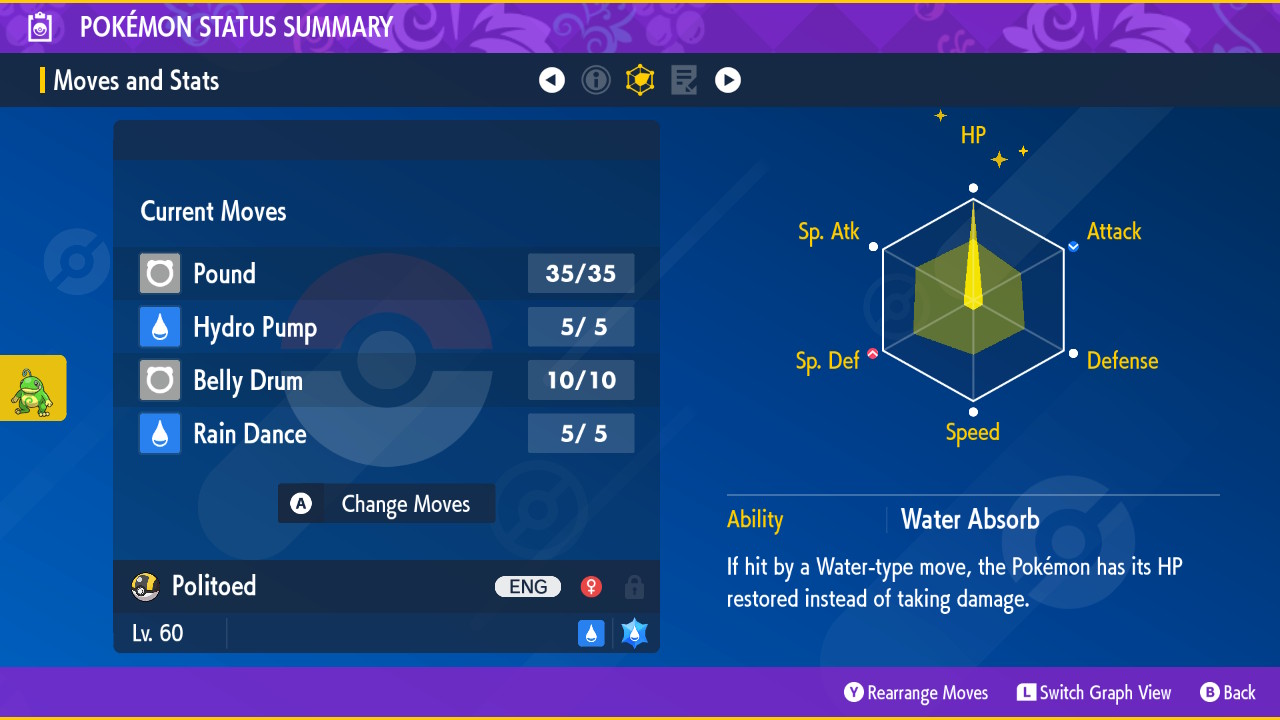
In general, when a Pokémon participates in or gains experience from a battle, it also gains EV points. Exactly what kind of EV points and how many are determined by the species of the defeated opponent. In other word, as you battle with your Pokémon, your Pokémon will gradually gain EVs. If you don't care what specific opponents you battle, then you're not purposefully choosing what those EV gains will be - your Pokémon just gets whatever it gets. But you can EV train your Pokémon in a particular way if you pick your battles carefully. This is the cheaper but more time-consuming method. When EV training through battles, you'll need to pre-plan exactly what wild Pokémon to battle and how many of them you need to KO.
We want Politoed to gain 252 Special Defense points through battling. Let's go over what we need. First, we need certain held items to equip. Next we need to identify the right Pokémon to battle: wild Pokémon that will give the kind of EVs we want. Then we need to figure out how many of them to KO in order to gain the number of points we want.
The Power training items are held items that improve the holder's EV gains from battling. With a Power item equipped, your Pokémon will gain 8 additional EV points for every KO. Those 8 extra EVs are determined by the Power item. For example, let's say your Pokémon is holding a Power Bracer, which gives bonus Attack EVs. Then you KO a Chansey, which gives +2 HP EVs. Your Pokémon gains +2 HP EVs from the Chansey plus +8 Attack EVs from the Power Bracer it's holding.
| Held Items for Earning EVs in Battle | ||||
|---|---|---|---|---|
| Item | Effect | Example Target | Example Target's EV Yield | Total EVs per Example KO |
| Power Weight | +8 HP EVs | Marill | +2 HP EVs | +10 HP EVs |
| Power Bracer | +8 Attack EVs | Veluza | +2 Attack EVs | +10 Attack EVs |
| Power Belt | +8 Defense EVs | Sudowoodoo | +2 Defense EVs | +10 Defense EVs |
| Power Lens | +8 Special Attack EVs | Golduck | +2 Special Attack EVs | +10 Special Attack EVs |
| Power Band | +8 Special Defense EVs | Hypno | +2 Special Defense | +10 Special Defense EVs |
| Power Anklet | +8 Special Defense EVs | Floatzel | +2 Speed EVs | +10 Speed EVs |
EV points CAN be gained by lvl 100 Pokémon. EV points can NOT be gained by fainted Pokémon. EV points can also NOT be gained from non-standard battle formats like Tera Raids, PvP battles, Auto Battles, Synchro Mode, certain boss battles encountered during the storyline, etc. Stick to regular wild Pokémon battles.
To train her Special Defense, we'll have Politoed hold a Power Band...
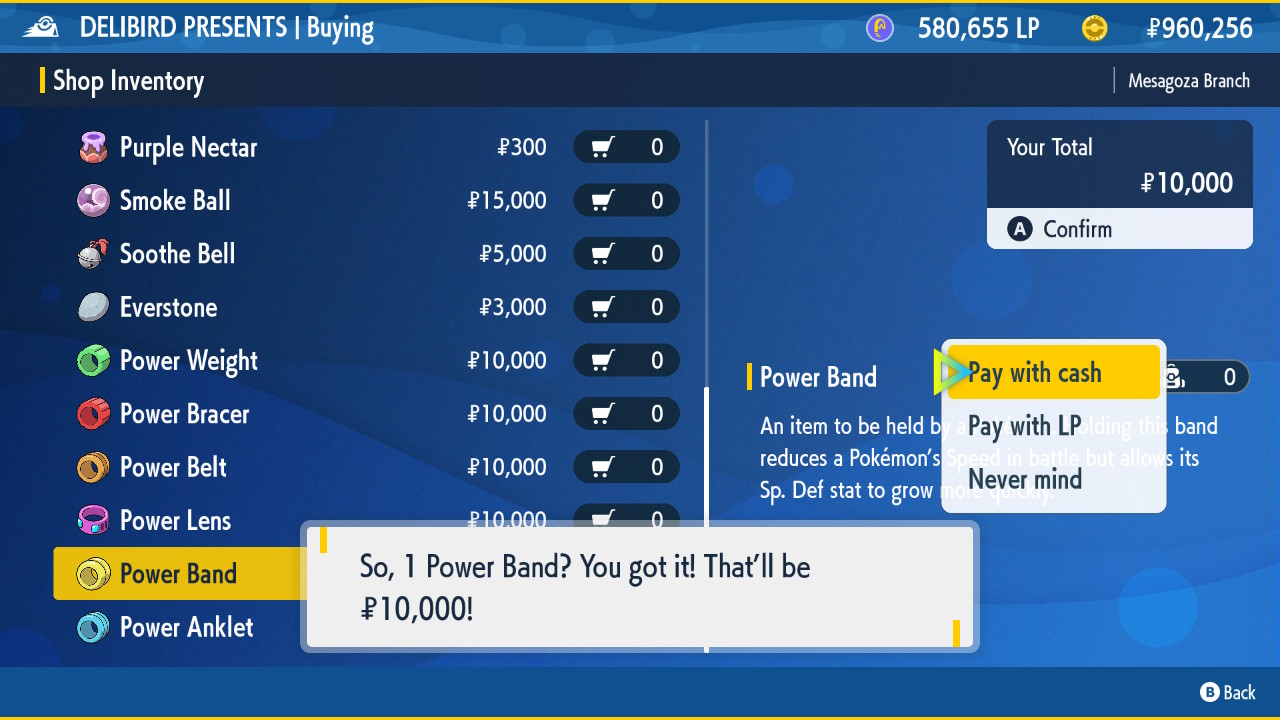
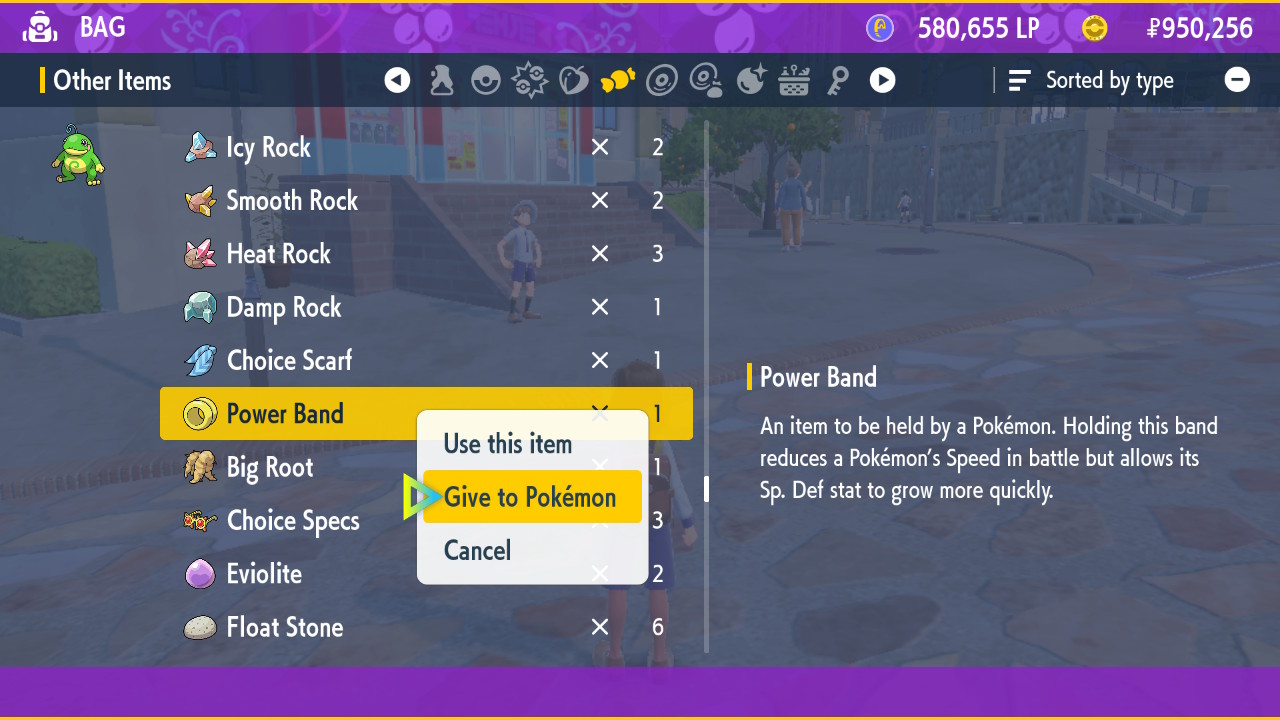
And beat up some Hypno. My go-to spot to find Hypno is the ruins east of Alfornada. With a Power Band equipped, we'd need Politoed to KO a total of 26 Hypno to earn 252 Special Defense EVs. (2 Hypno Sp.Def EVs + 8 Power Band Sp.Def EVs) * 26 KOs = 260 Sp.Def EVs earned = 252 Sp.Def EVs gained. Because 252's the limit, remember?
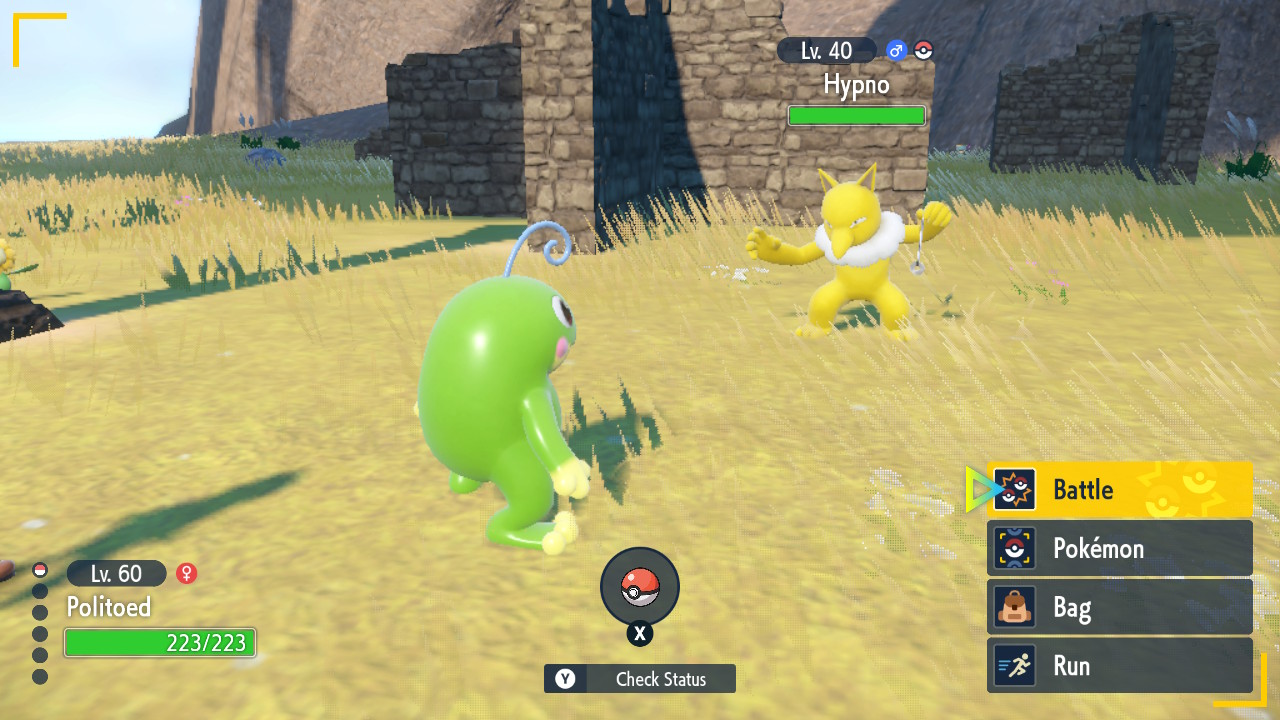
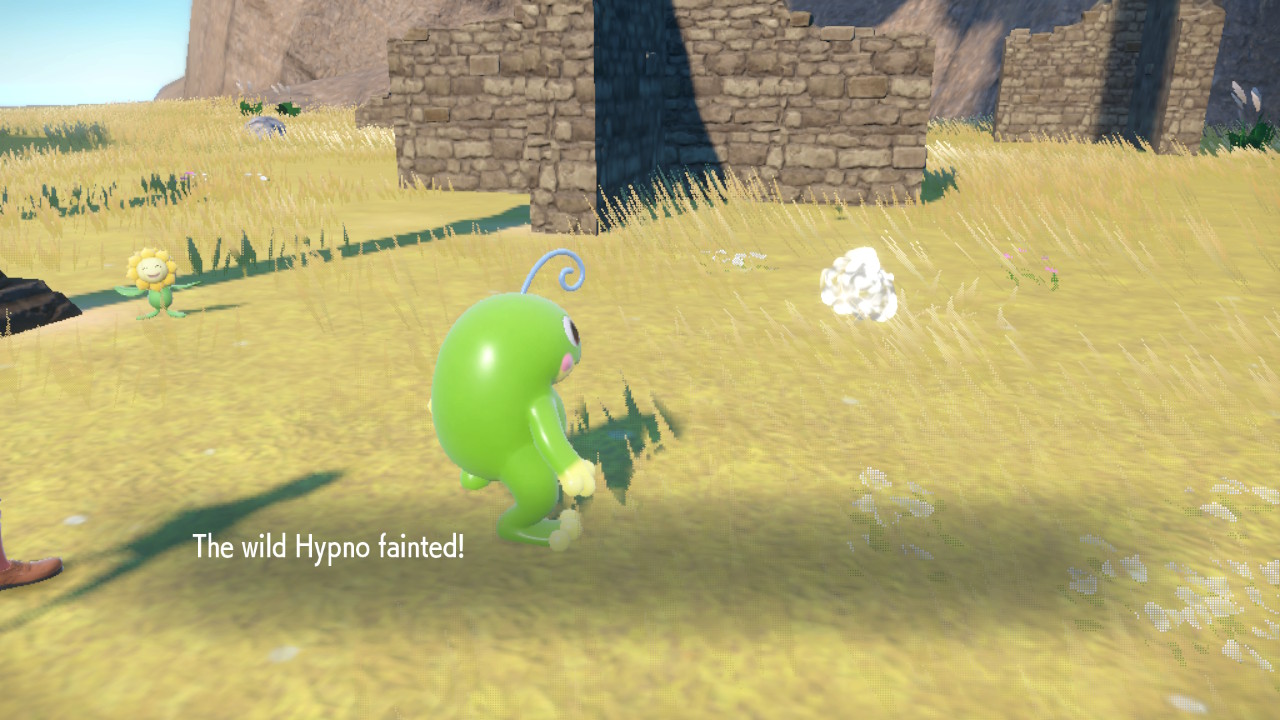
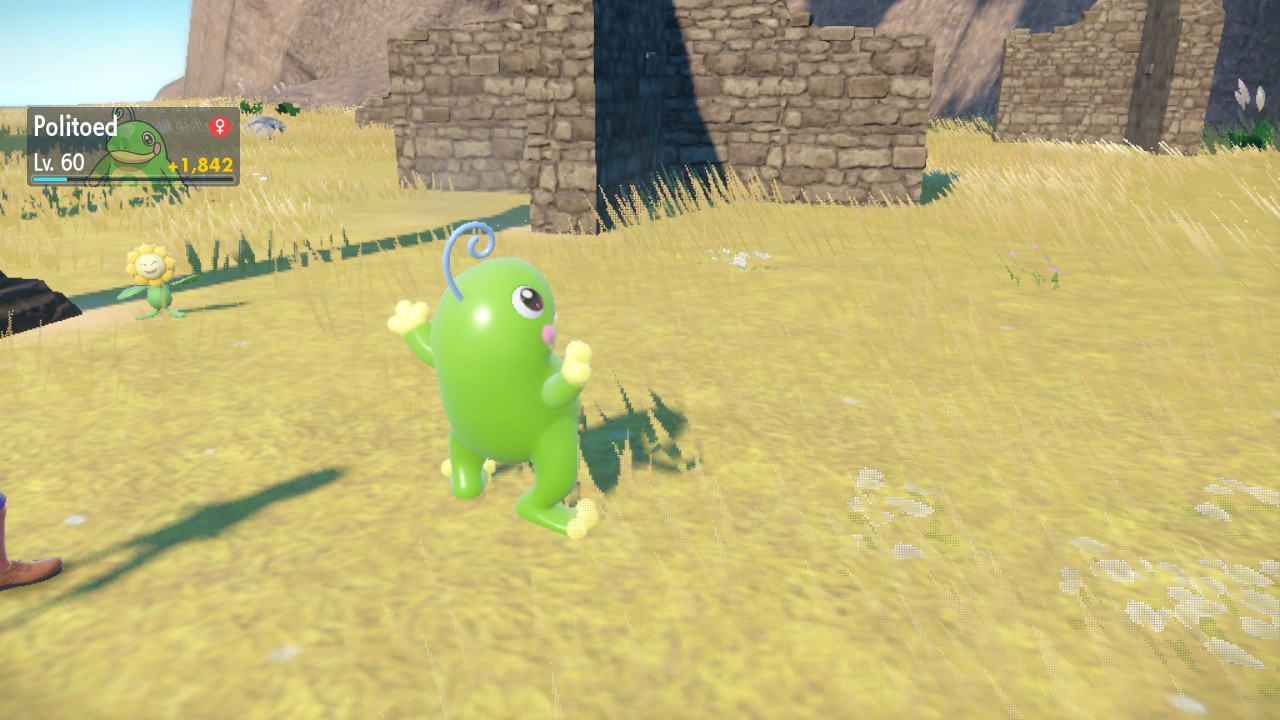
Politoed can unequip the Power Band when we're finished. (The Power items' in-game descriptions mention a Speed penalty. Don't worry, this effect is temporary. It only lasts while your Pokémon is actually holding the Power item.)
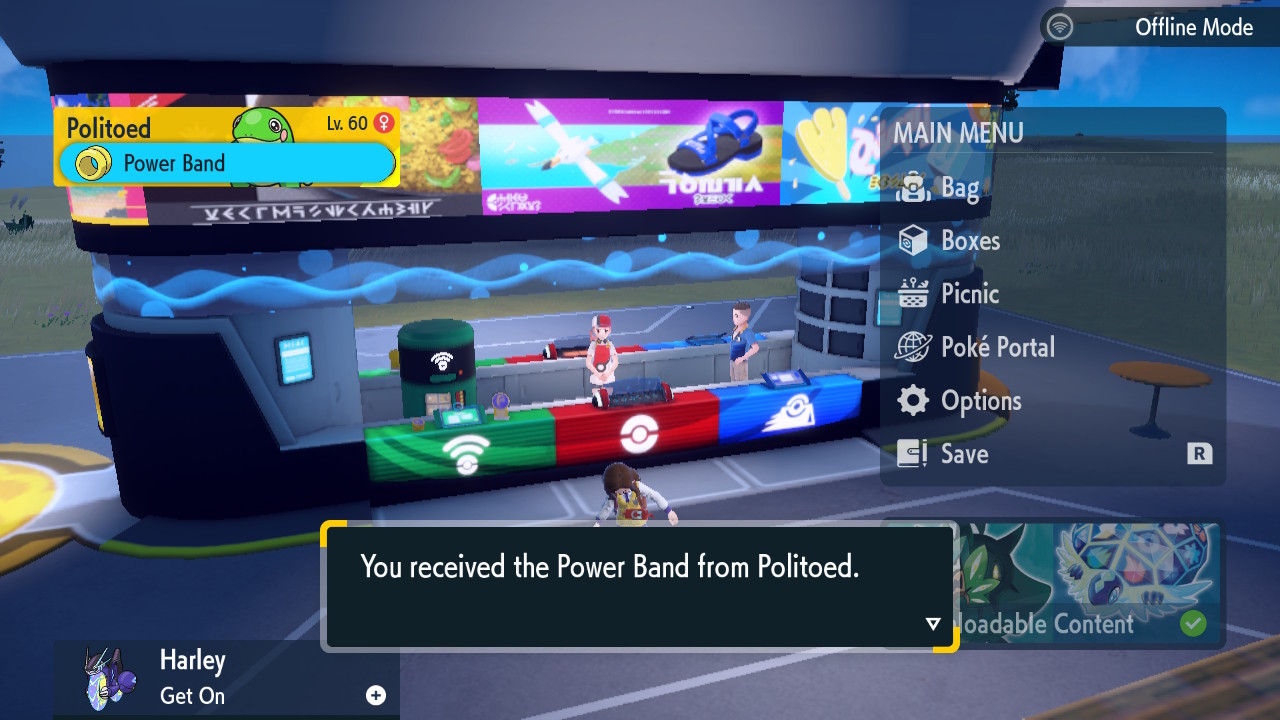
Here's how Politoed's stats changed: Special Defense increased from 148 to 190 (+42).
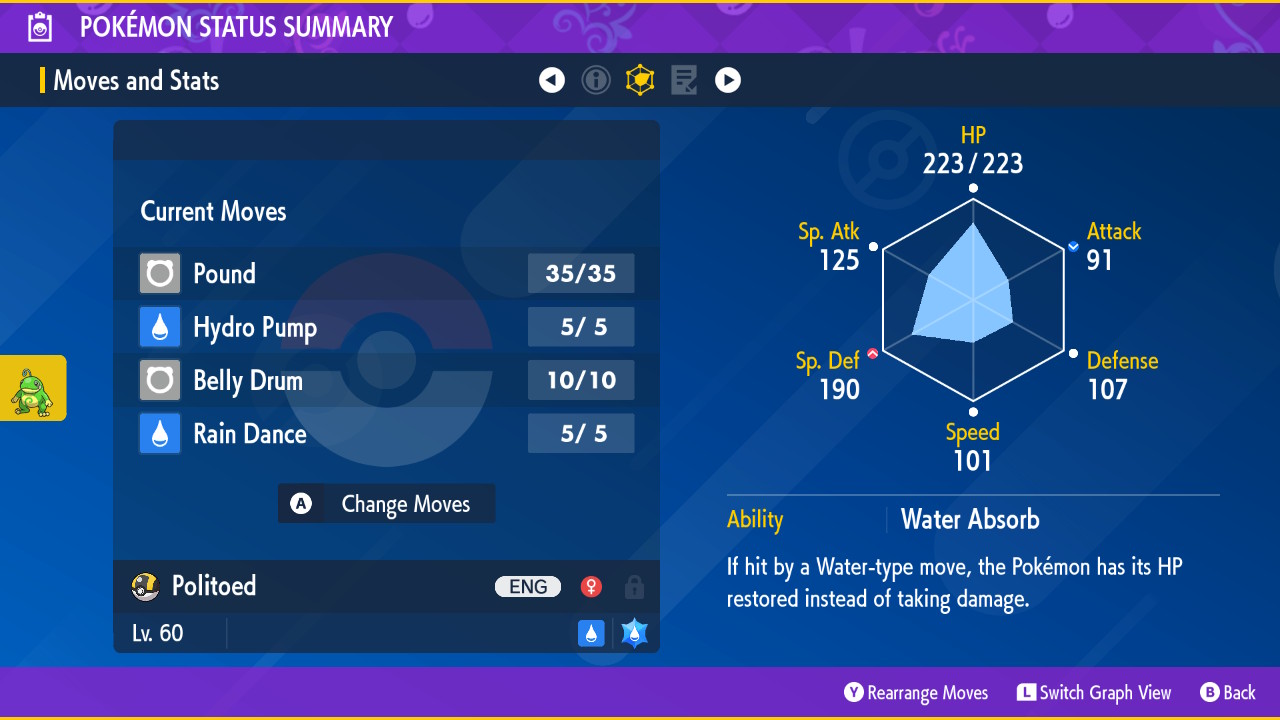
Politoed's Special Defense EVs are maxed out. Again, to indicate this, you will see a sparkle effect on Special Defense on the EV chart in the Pokémon's stat summary.
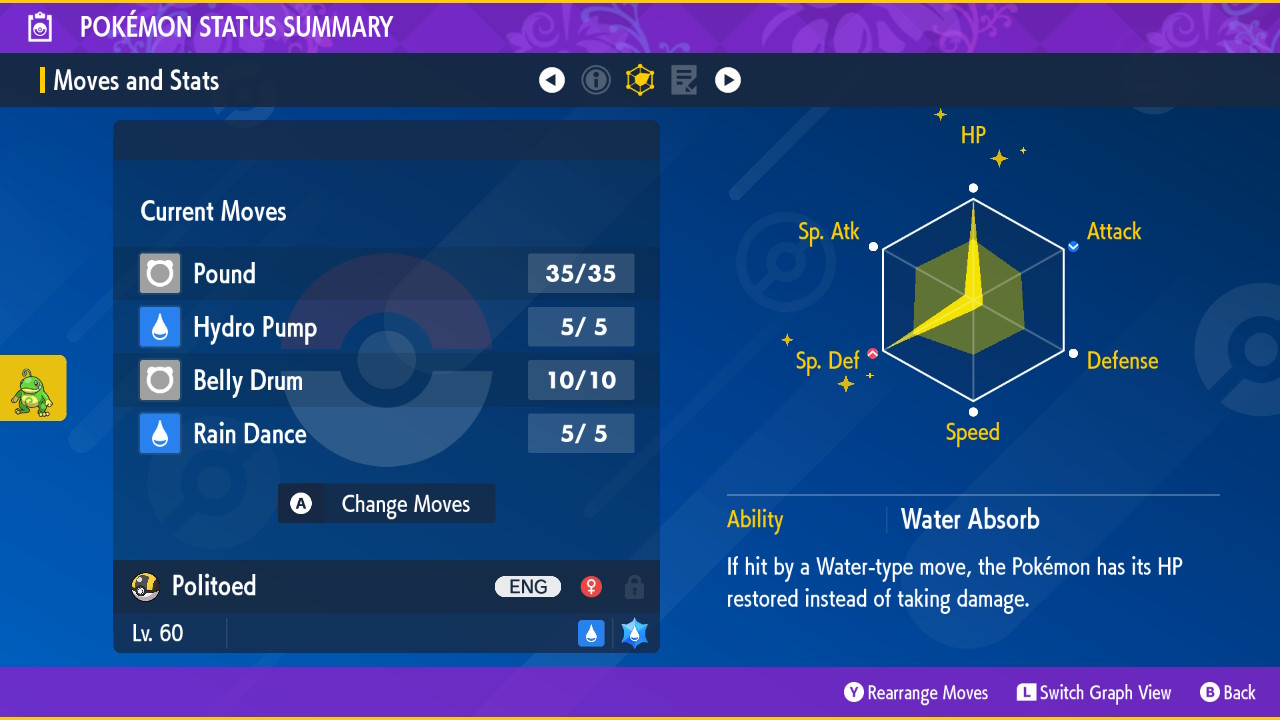
In the previous two sections Politoed gained a total of 504 EV points. She can gain 6 more points before hitting the overall cap of 510. We'll dump these into Special Attack using 6 Genius Feathers. 6 EV points won't make much of a difference, but it's better than nothing.

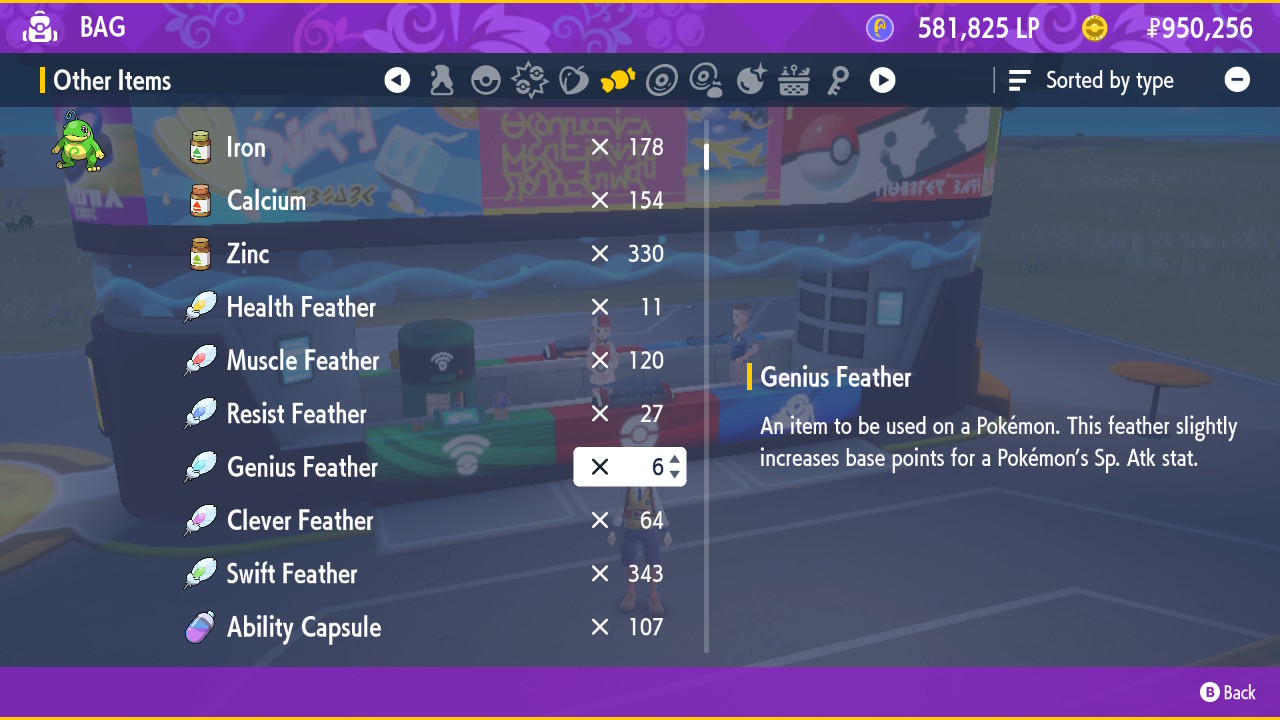
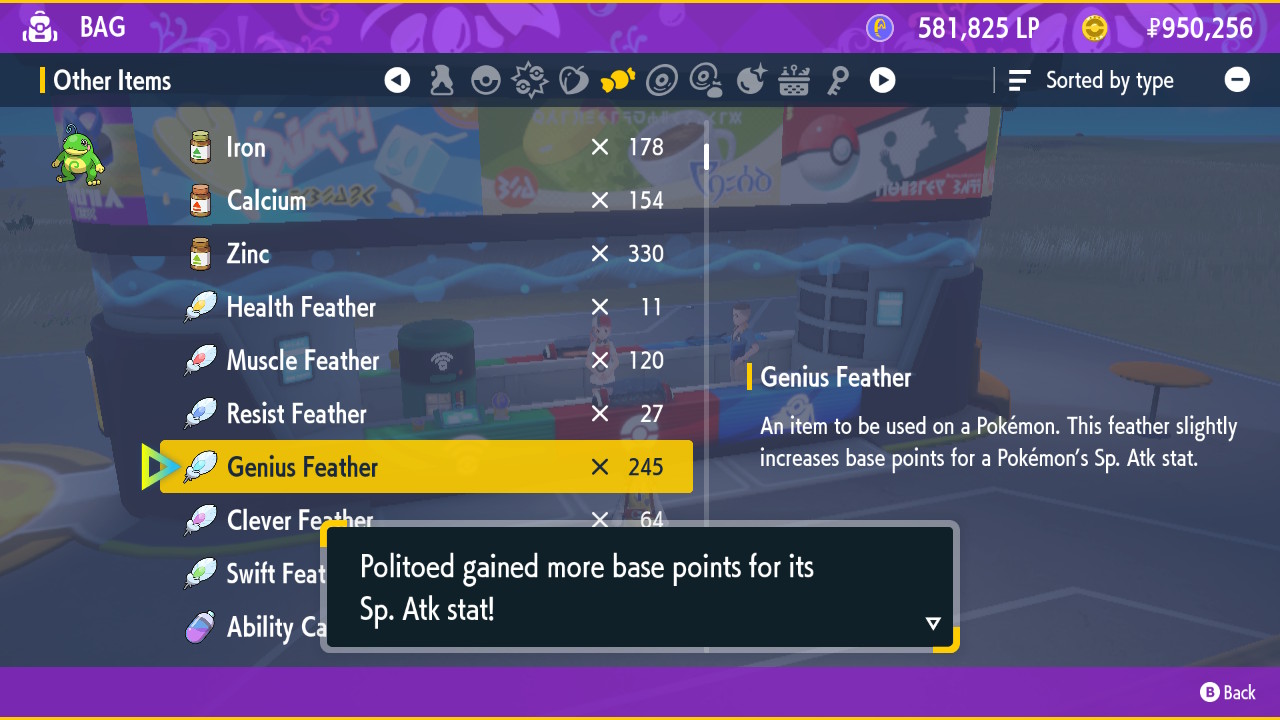
EV training complete! Here's how Politoed's stats changed: Special Attack increased from 125 to 126 (+1).
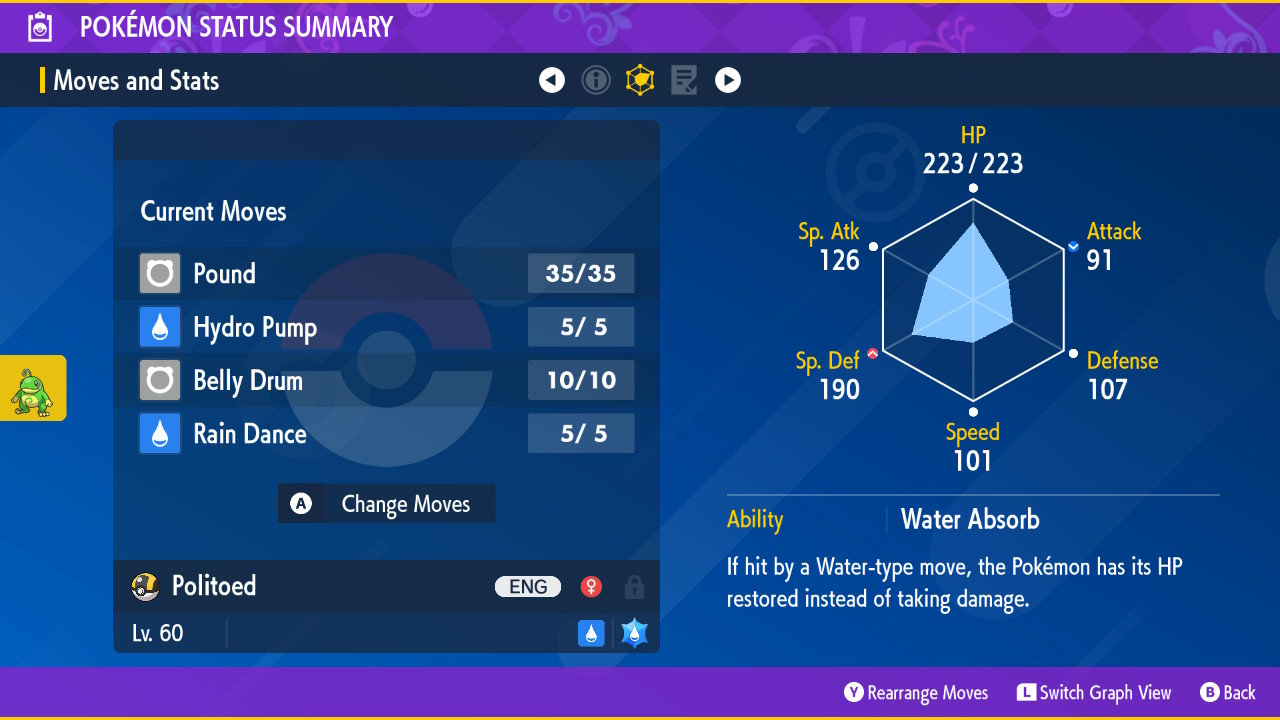
Notice that the EV chart has now changed from yellow to blue, indicating that Politoed can't gain any more EV points. There are sparkle effects on HP and Special Defense, indicating that those two stats have gained the maximum amount of EV points.
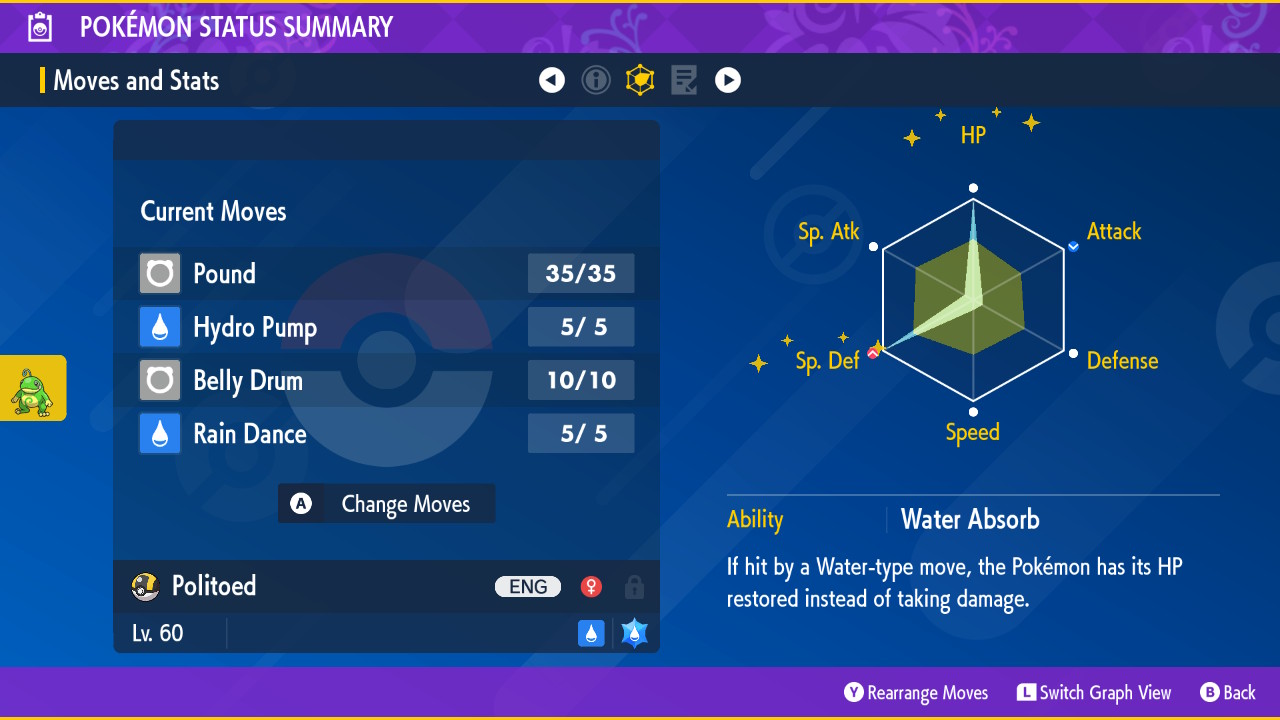
As a fully trained Pokémon, Politoed now qualifies for the Effort Ribbon. This achievement awards the title "the Once Well-Trained." I like to get all the Pokémon I EV train this ribbon.
The Effort Ribbon is handed out by a girl with a Luxio in the courtyard of south-central Levincia.
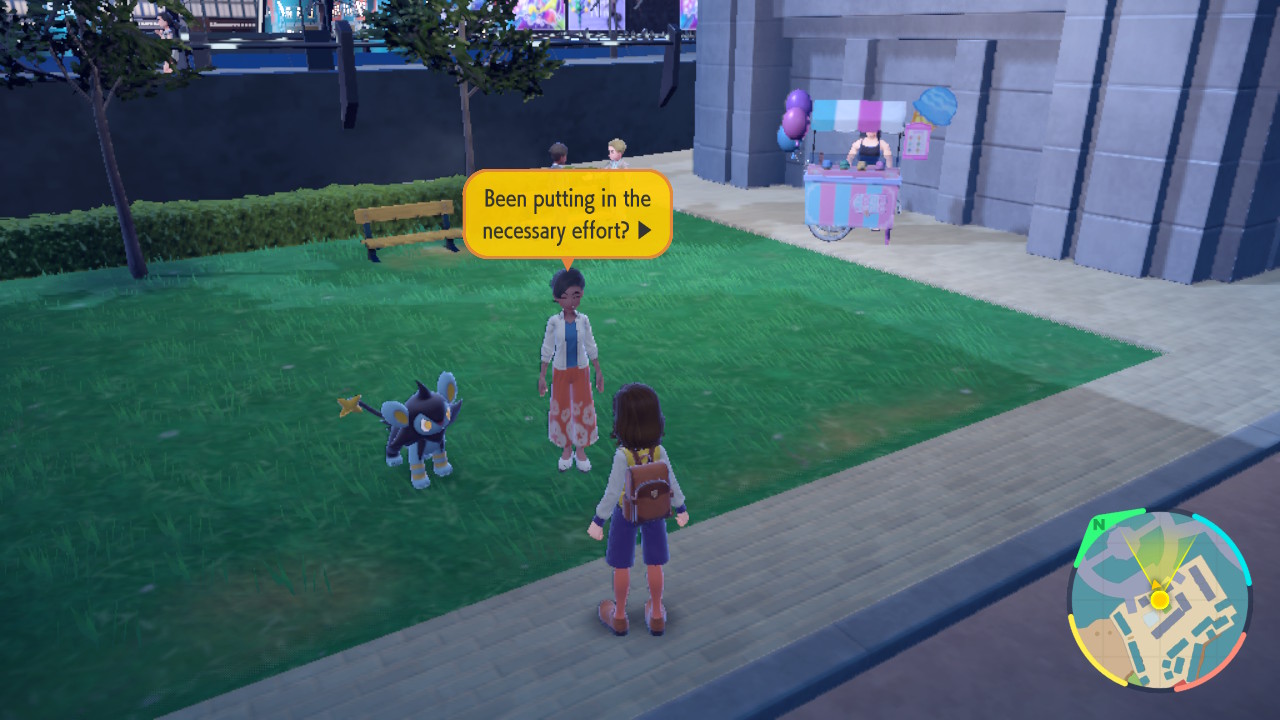

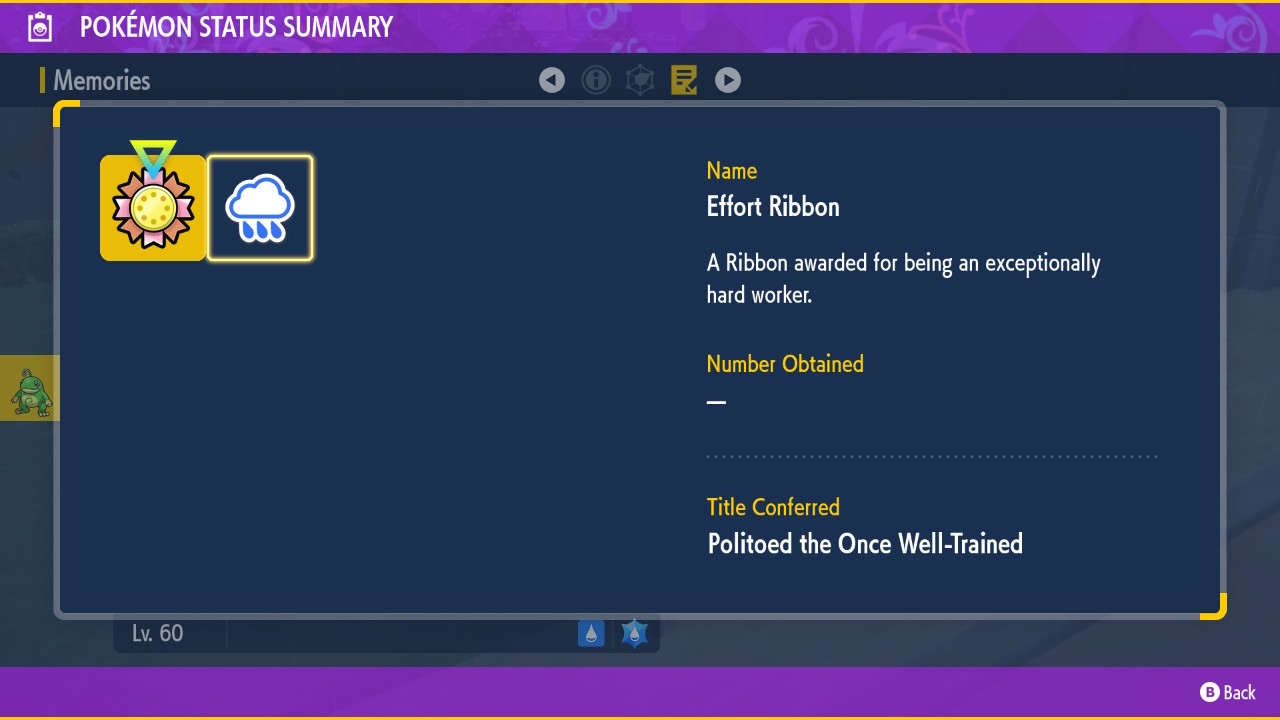
Changed your mind or made a mistake with EV training? There are a couple of ways to remove your Pokémon's EVs and start over. Use these items:
| Consumables for Losing EV Points | |
|---|---|
| Item | Effect |
| Pomeg Berry | -10 HP EVs |
| Kelpsy Berry | -10 Attack EVs |
| Qualot Berry | -10 Defense EVs |
| Hondew Berry | -10 Special Attack EVs |
| Grepa Berry | -10 Special Defense EVs |
| Tamato Berry | -10 Speed EVs |
| Fresh-Start Mochi | -All EVs |
There is no limit to the number of times you can remove and redistribute a Pokémon's EV points. The berries can be picked up off of the ground in Paldea Area Two, and Fresh-Start Mochi can be won as a prize at the Ogre Oustin' game at the Kitakami Festival.
I prefer to focus on leveling up my Pokémon after I've finished EV training them so I don't have to worry about accidentally gaining unwanted EV points. This is up to personal preference, though. Feel free to grind or use exp candy - whatever you prefer - at any point during the training process. The final results will be the same, no matter when you perform each step.
I have way more than enough exp candies, so let's feed some to Politoed now. Level 100: the pinnacle of power for a Pokémon!
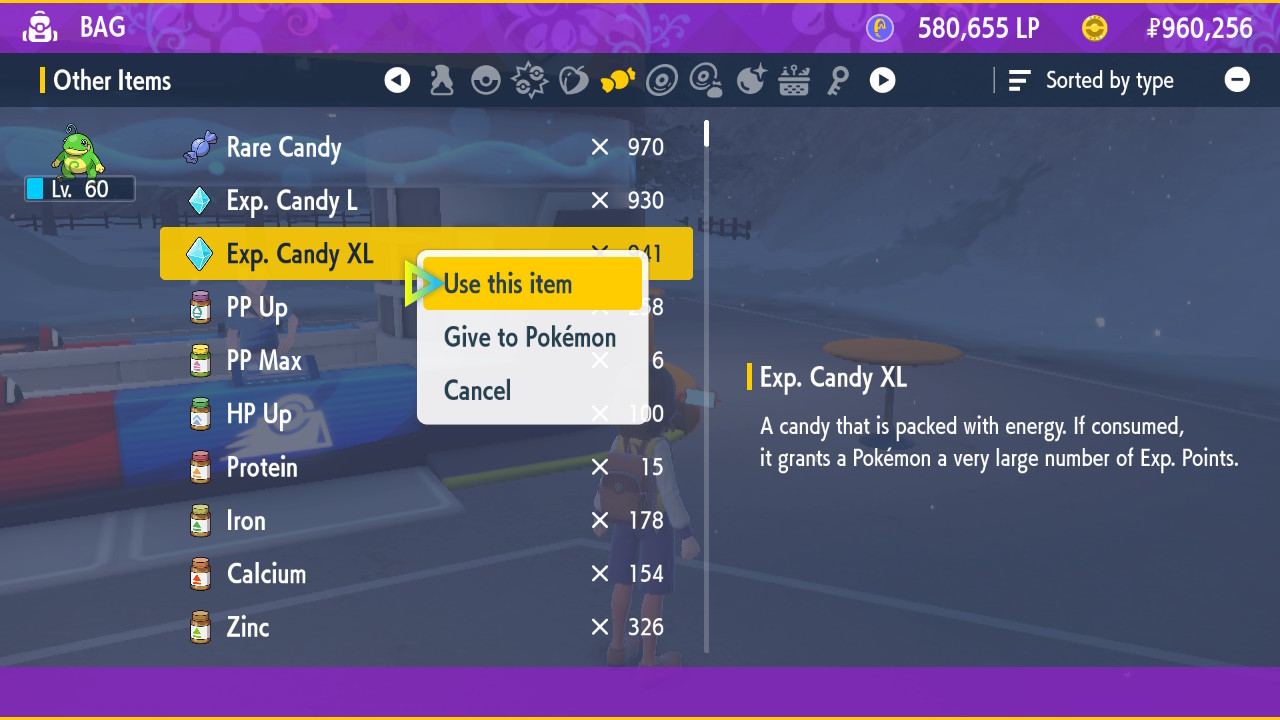
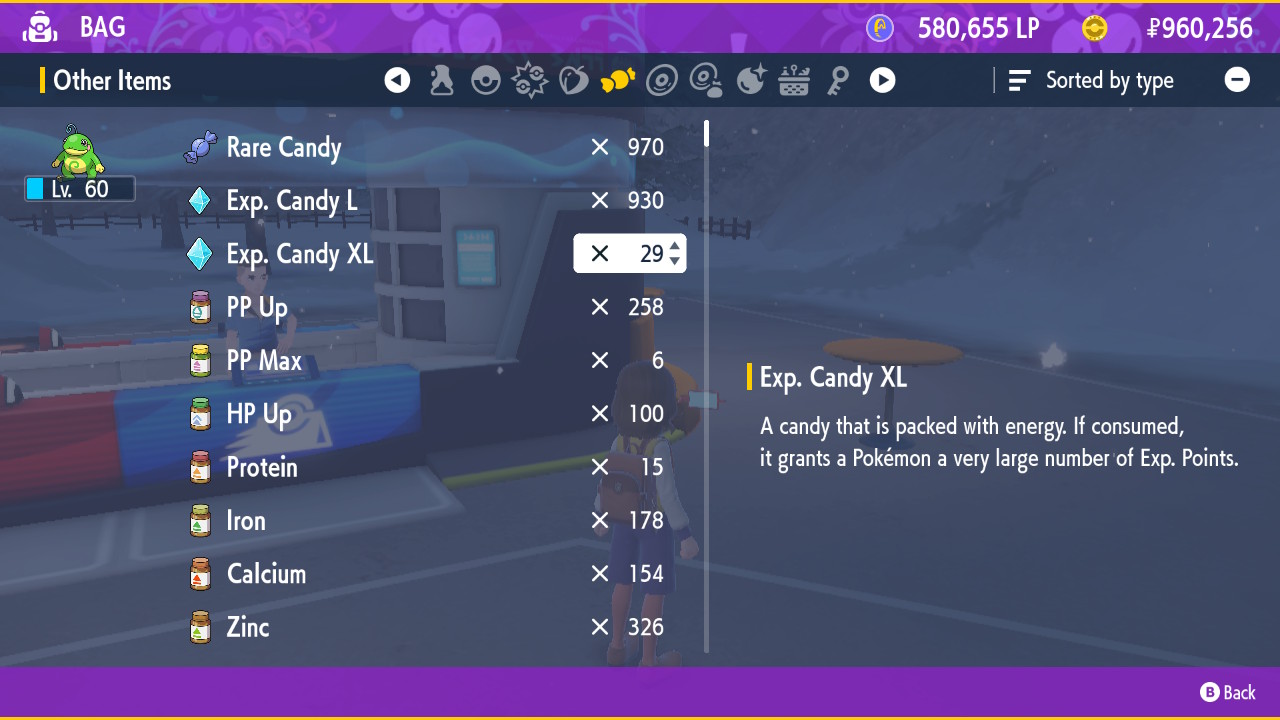
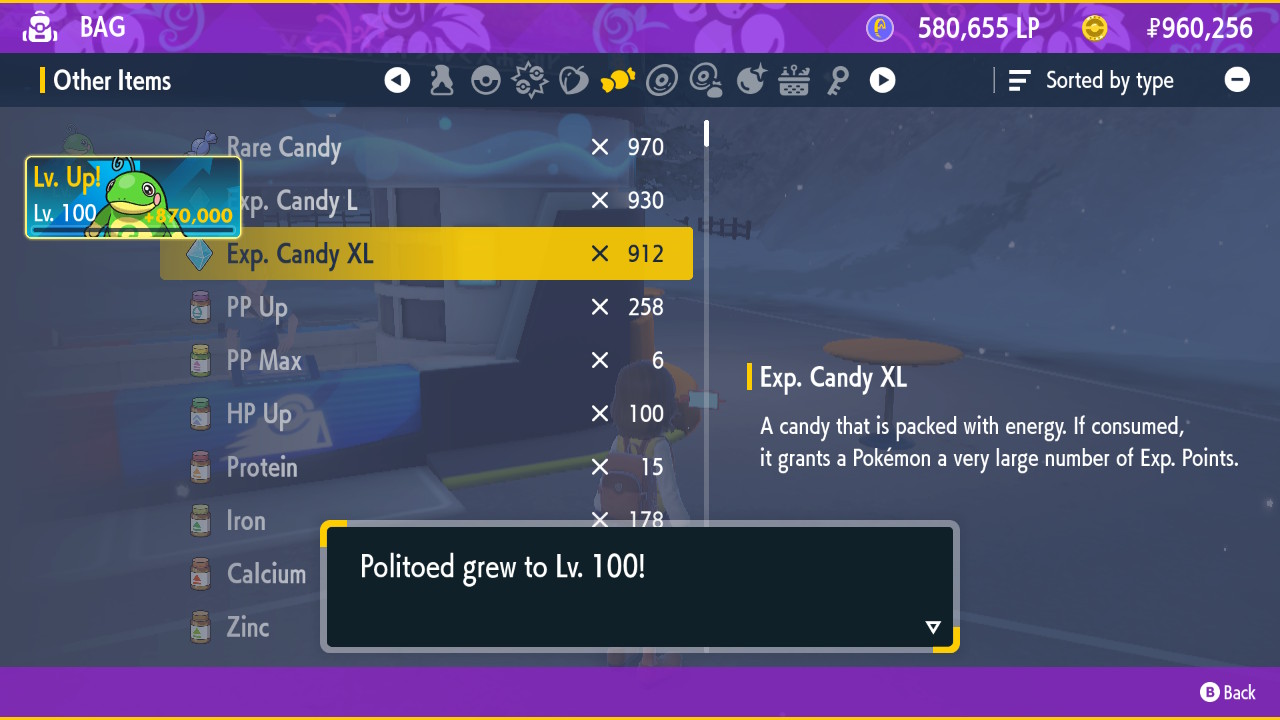
Unsurprisingly, Politoed gets a massive stat boost: HP increased from 223 to 366 (+143). Attack increased from 91 to 150 (+59). Defense increased from 107 to 176 (+69). Special Attack increased from 126 to 207 (+81). Special Defense increased from 190 to 313 (+123). Speed increased from 101 to 165 (+64).
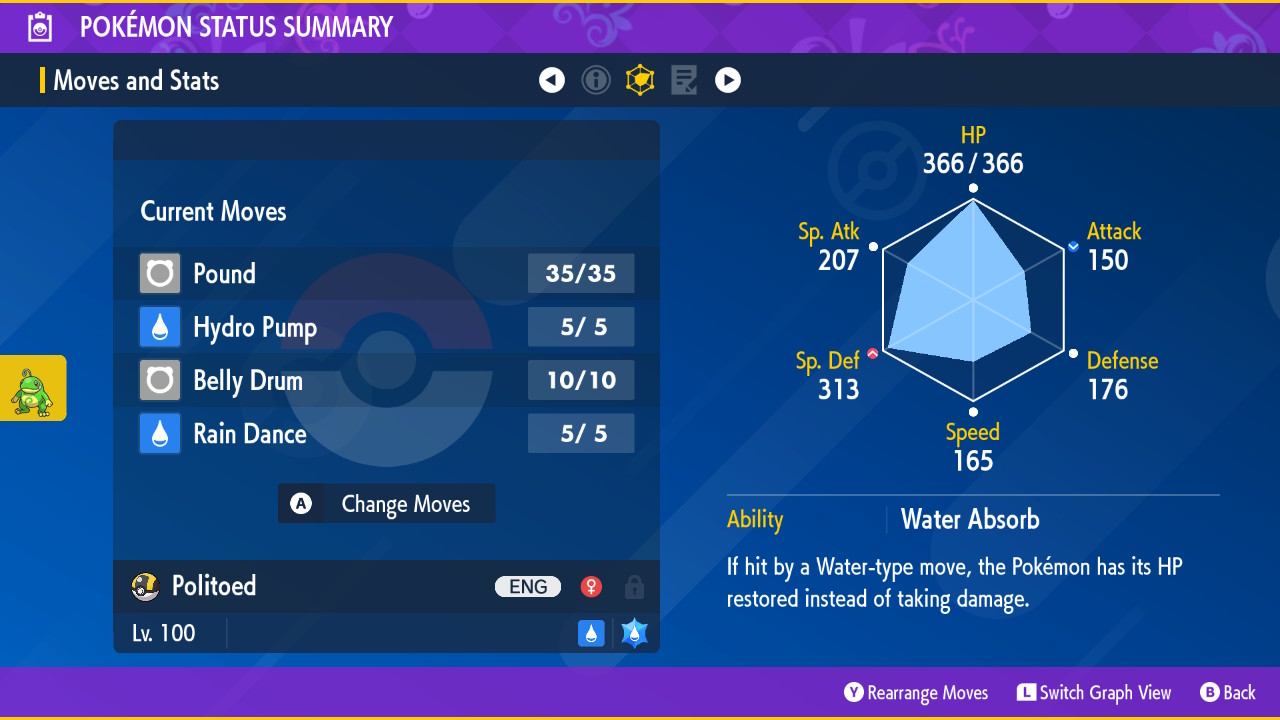
Notice how Politoed's HP and Special Defense grew a lot more than all her other stats!
Individual Values (IVs, also known as individual strengths) are the other set of unique values that make specific individual Pokémon different from others of the same species. IVs determine a Pokémon's innate capability to raise its stats; you can think of IVs as a Pokémon's 'genes,' representing the concept that every Pokémon is a unique individual creature with its own natural talents. Some can move faster than others, some have better endurance, some hit harder, etc. IVs diversify Pokémon of the same species and level, so that Jenny's level 20 Pikachu isn't quite the same as Jimmy's level 20 Pikachu. Every single Pokémon, when it's encountered or bred, is assigned a set of six IVs (one for each of its six stats). These values determine the Pokémon's innate potential for that stat. IVs range from 0 (the worst stat growth) to 31 (the best stat growth).
This chart displays the Judge assessment of Politoed's stat growth potential.
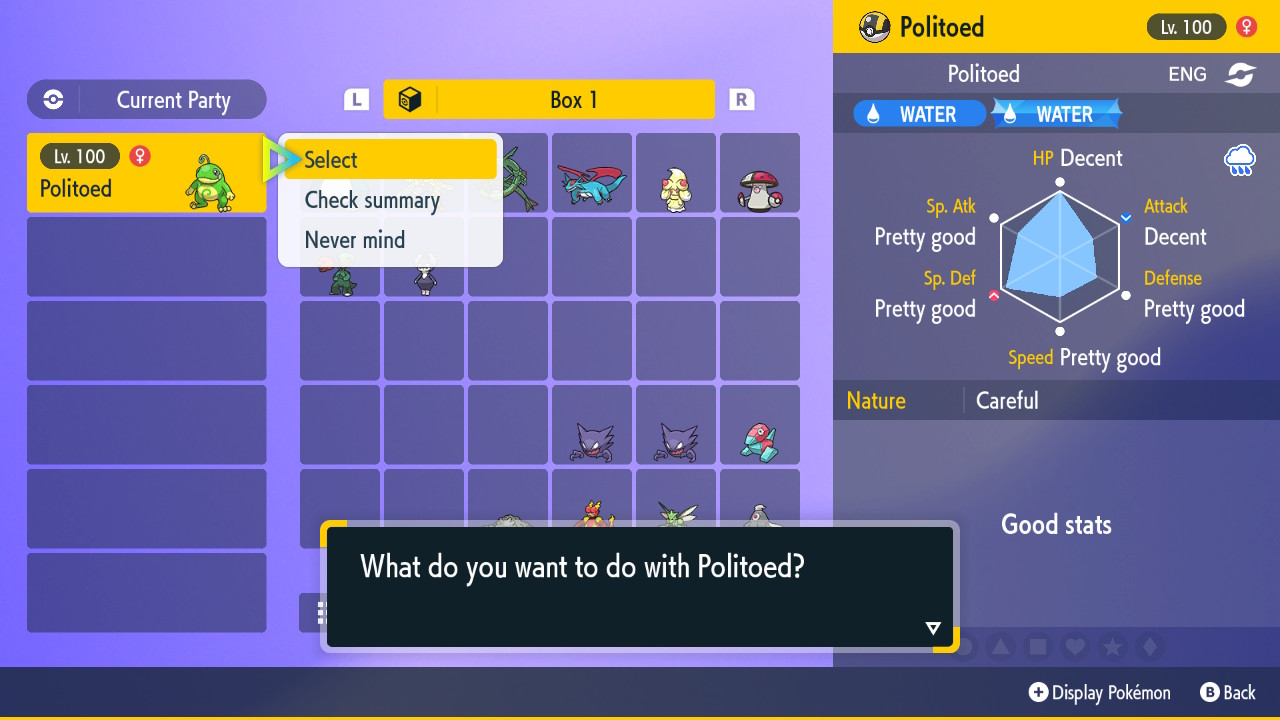
This tells us that our Politoed here is Decent at HP and Attack, and Pretty Good at everything else, relative to other Politoed. Her overall quality is Good.
Hyper training immediately increases a Pokémon's stat growth potential to the maximum, causing the associated stat to be recalculated as though the IV were the highest possible value (31). If IVs are a Pokémon's genes, then hyper training is gene therapy. The actual IV does not change, but the associated stat value does, like using a mint to optimize a specific stat. Functionally there is no stat difference between a naturally "best" IV and a hyper trained IV. Hyper training is purchased with items called Bottle Caps, which themselves can be purchased at Delibird Presents in Mesagoza.
Let's optimize Politoed's genes. We'll visit the Hyper Trainer, a man with an Abomasnow near the Pokémon Center in Montenevera.

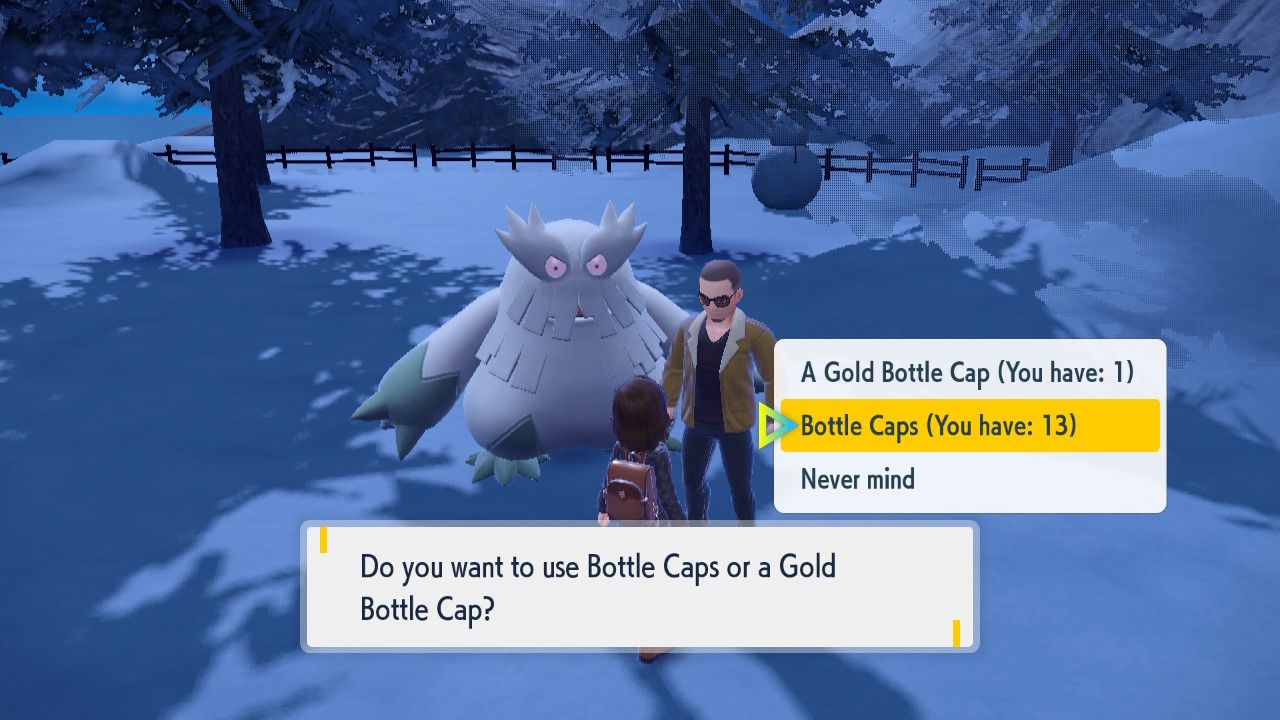
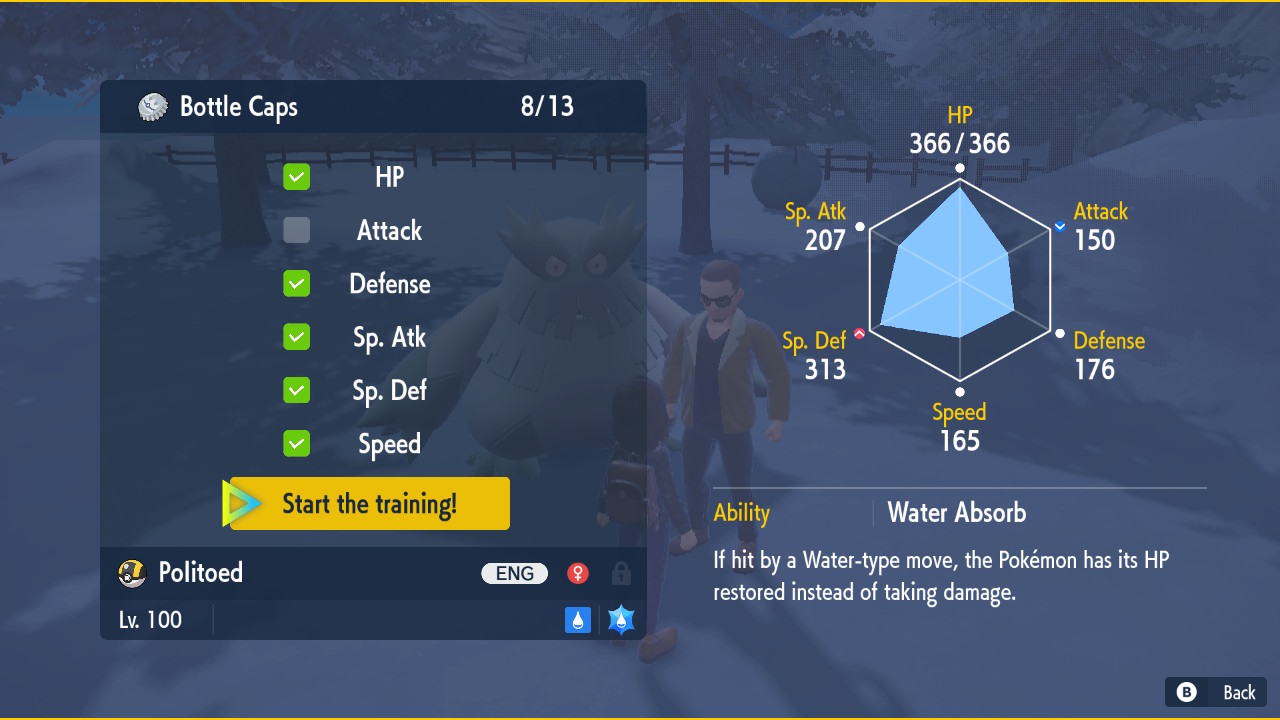
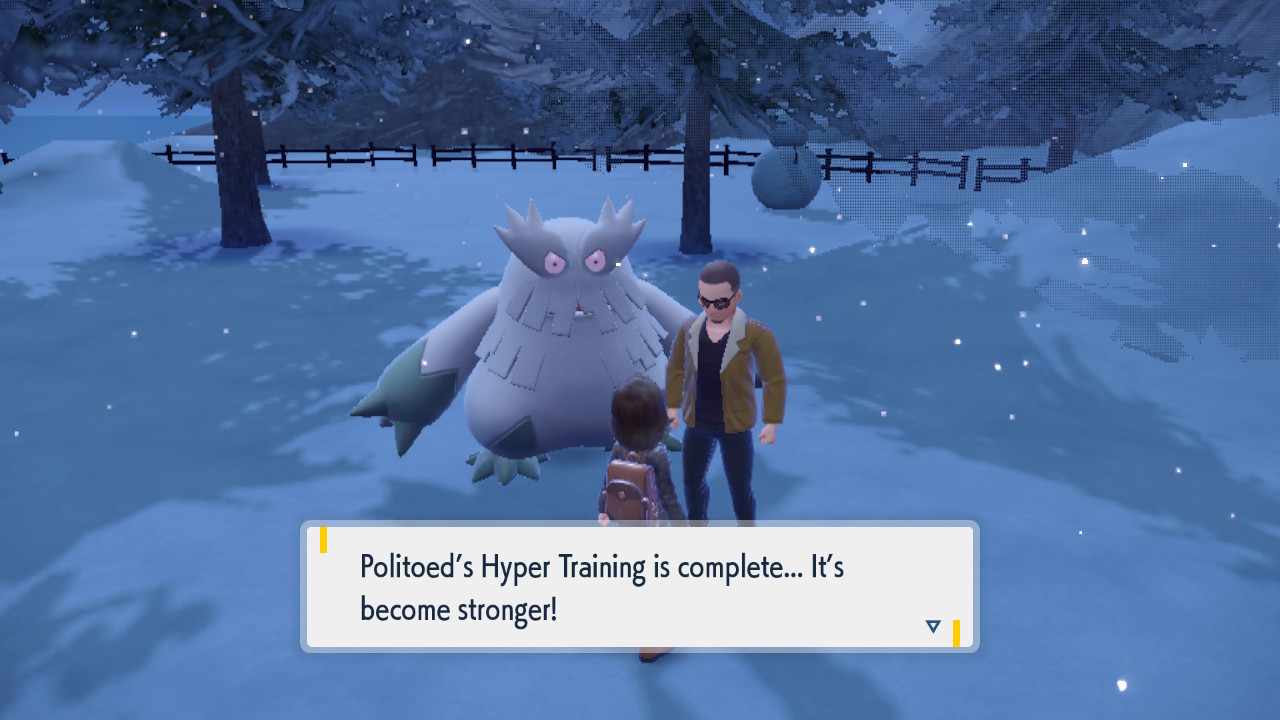
Five Bottle Caps later... The chart now shows each IV we augmented as "Hyper trained!", and Politoed's overall quality has correspondingly increased to Amazing. She is now a genetically perfect specimen of a Politoed, with optimal stats in all the areas we care about. (I could have hyper trained Politoed's Attack too, but I didn't bother because I don't care about her Attack stat.)
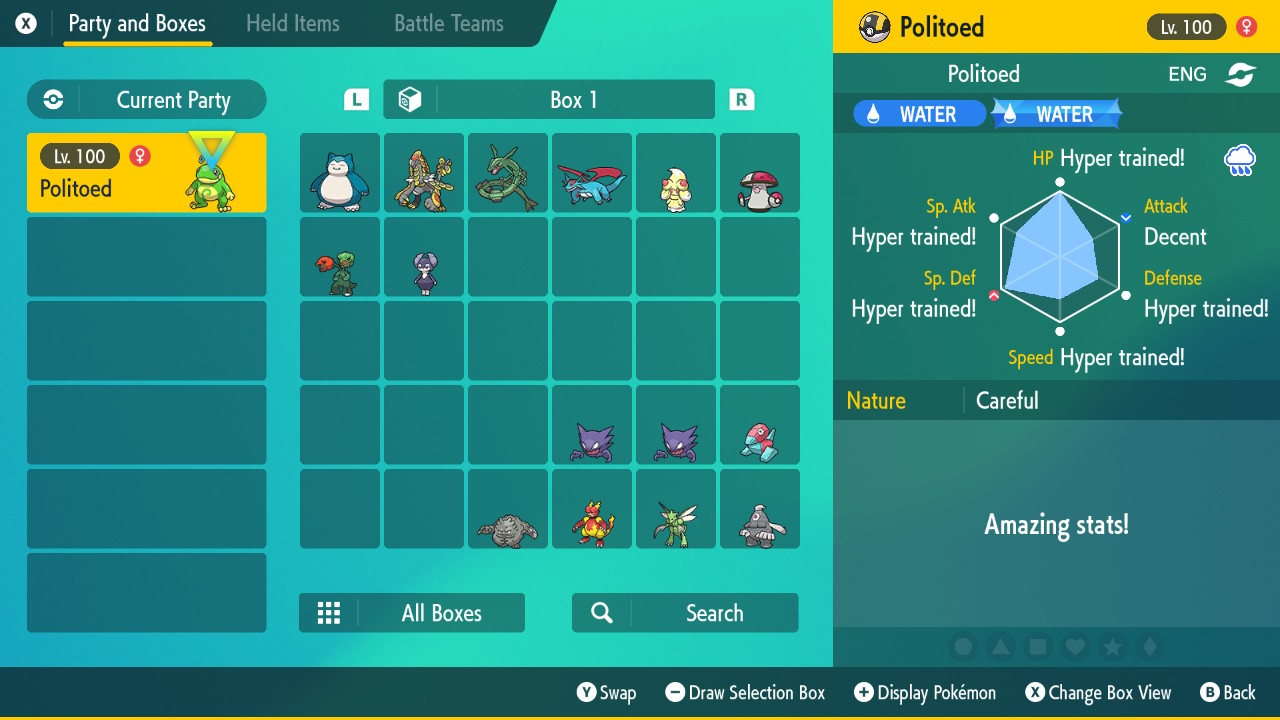
Here's how Politoed's stats changed: HP increased from 366 to 384 (+18). Attack stayed the same. Defense increased from 176 to 186 (+10). Special Attack increased from 207 to 217 (+10). Special Defense increased from 313 to 328 (+15). Speed increased from 165 to 176 (+11).
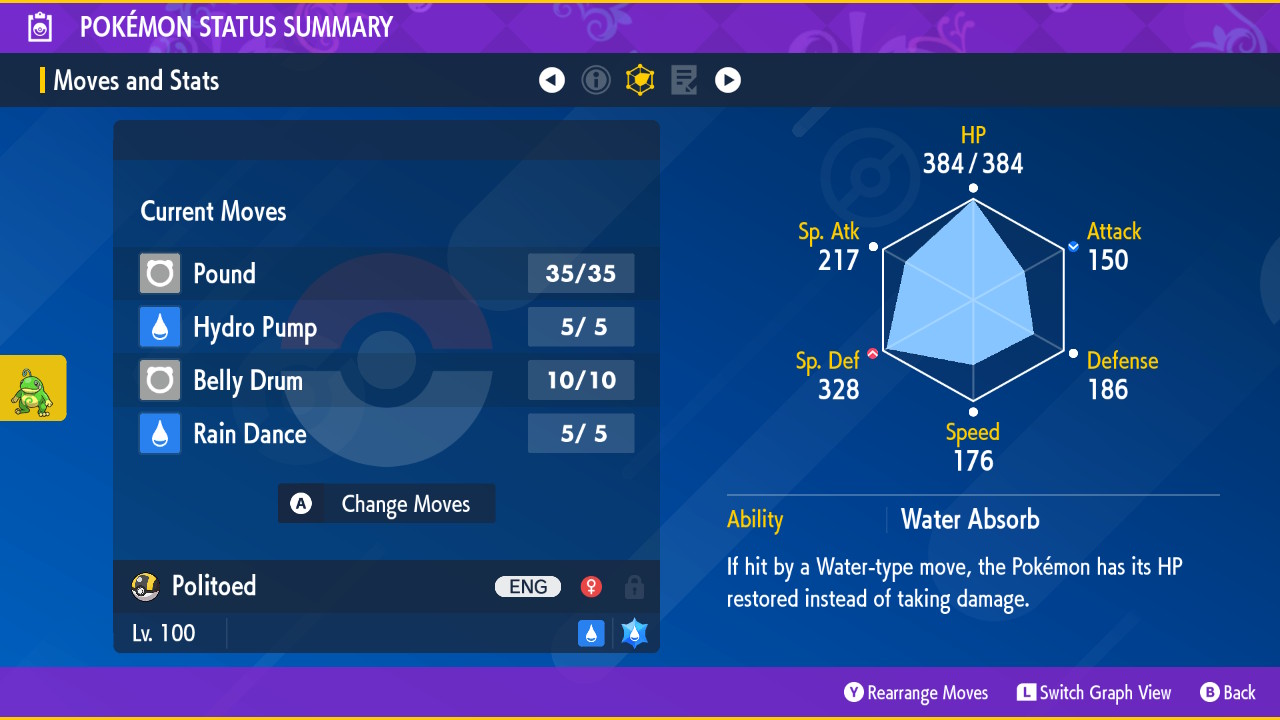
At this point Politoed's stat training is complete. But we're not finished quite yet. Politoed's ability is Water Absorb, which is fine, but... Politoed's Rainy Mark is a perfect match for Drizzle!
The Ability Capsule and Ability Patch are two similar consumable items that change a Pokémon's ability. When you use an Ability Capsule or Patch on your Pokémon, its ability changes to another one of its species' abilities. The change is permanent until you use another Ability Capsule or Patch on your Pokémon, which you can do as many times as you'd like. Ability Patches change to and from hidden abilities; Ability Capsules change between standard abilities.
In this case we need an Ability Patch to change Water Absorb, a standard ability for Politoed, into Drizzle, a hidden ability.
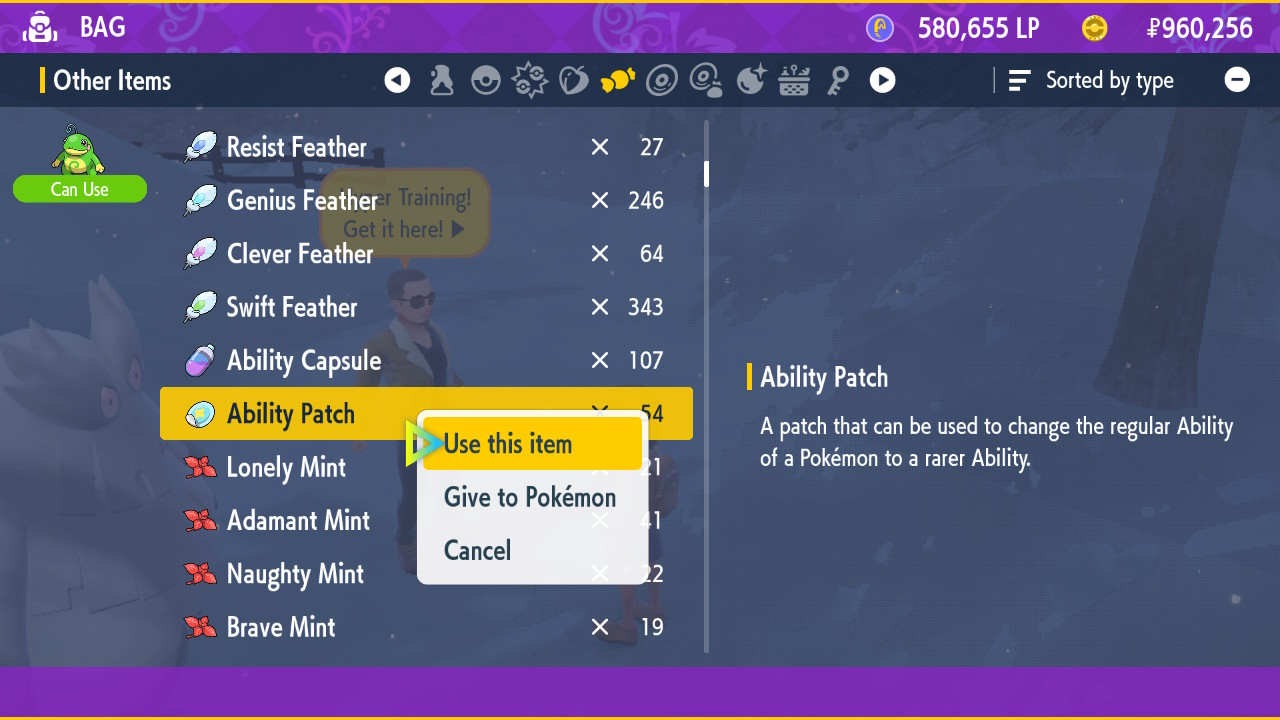
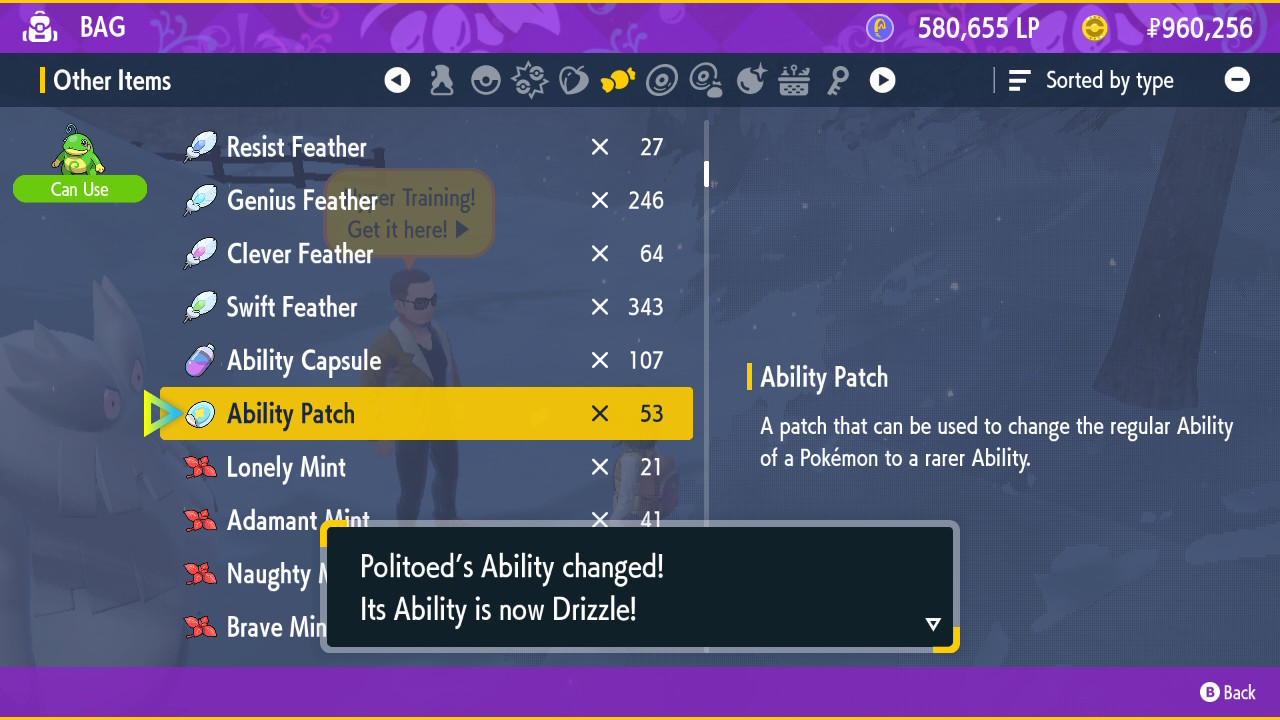
Politoed's current moveset also definitely needs improvement... Pound is just embarassing.
Do you know the difference between physical and special attacks? Physical attacks use the attacker's Attack stat and the target's Defense stat to calculate damage. Special attacks use the attacker's Special Attack stat and the target's Special Defense stat to calculate damage. (There are a few rare exceptions to the rule.) You can check whether an attack is physical or special by looking at its category icon. Physical attacks have an icon that looks like an explosion ; special attacks have an icon that looks like concentric rings.
When selecting moves for your Pokémon, choose attacks that take advantage of its higher offensive stat! In Politoed's case, that's Special Attack. Let's review the moves Politoed can learn. (Click here to view them on PokémonDB.) We find that Politoed has access to a decent variety of special attacks and support moves. Keeping in mind that I'd like to use Politoed in Tera Raids, I'll select some moves that will be good for raiding.
Let's go with Chilling Water and Mud Slap to debuff raid bosses, Surf for consistent Water damage, and... not sure about that last slot... how about Ice Beam just as filler for now.
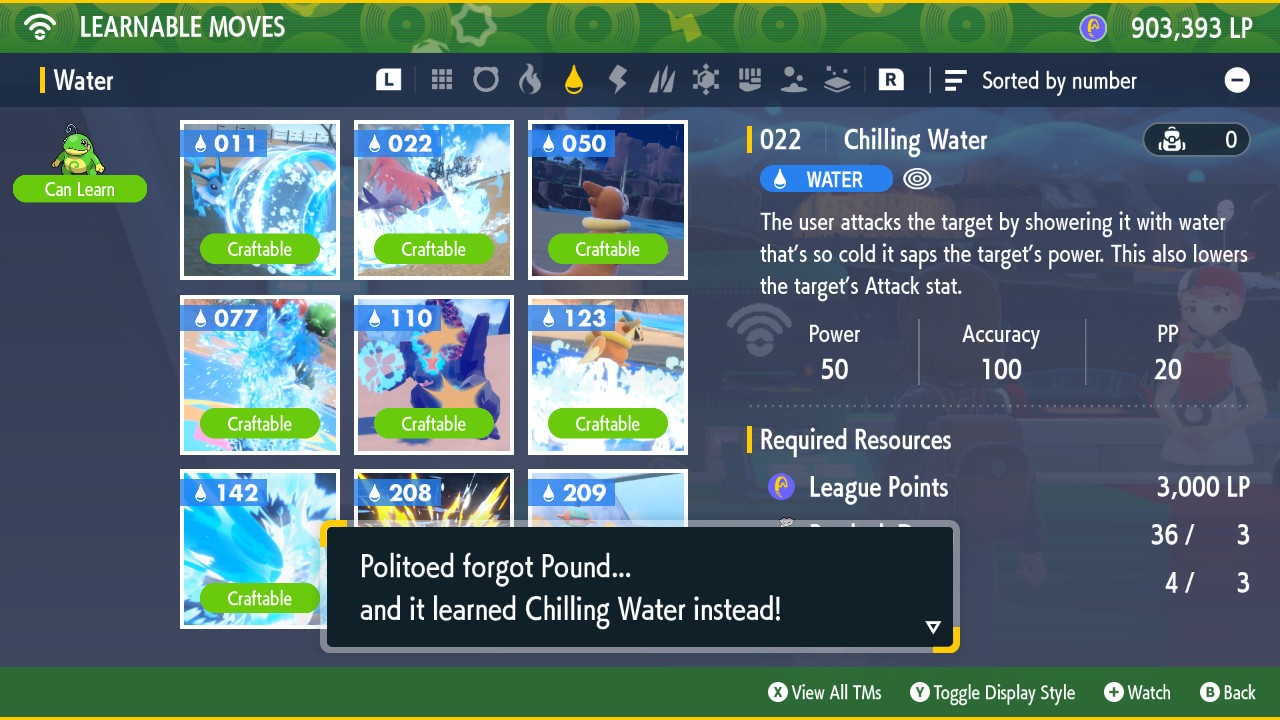
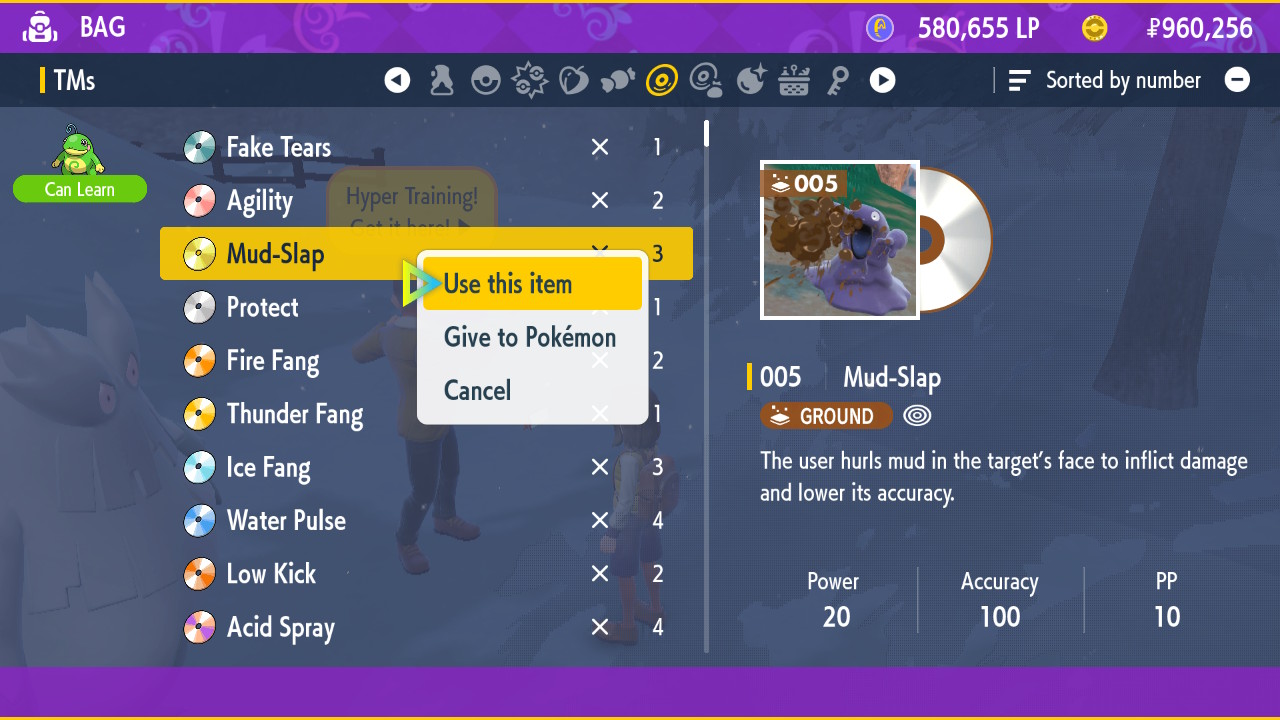
That's looking MUCH better!
Politoed has been turned into a soggy froggy powerhouse; in particular, Politoed's training has given her the absolute maximum HP and Special Defense possible for a Politoed, plus a tiny extra boost to Special Attack. Here's her final build:
- Politoed the Sodden
- Level: 100
- Nature: "Calm" (+Sp.Def, -Atk)
- Ability: Drizzle
- Stats: 384 HP / 150 Atk / 186 Def / 217 Sp.Atk / 328 Sp.Def / 176 Spd
- EVs: 252 HP / 0 Atk / 0 Def / 6 Sp.Atk / 252 Sp.Def / 0 Spd
- IVs: "Best" HP / 12 Atk / "Best" Def / "Best" Sp.Atk / "Best" Sp.Def / "Best" Spd (31/12/31/31/31/31)
- Moves: Chilling Water, Surf, Ice Beam, Mud Slap
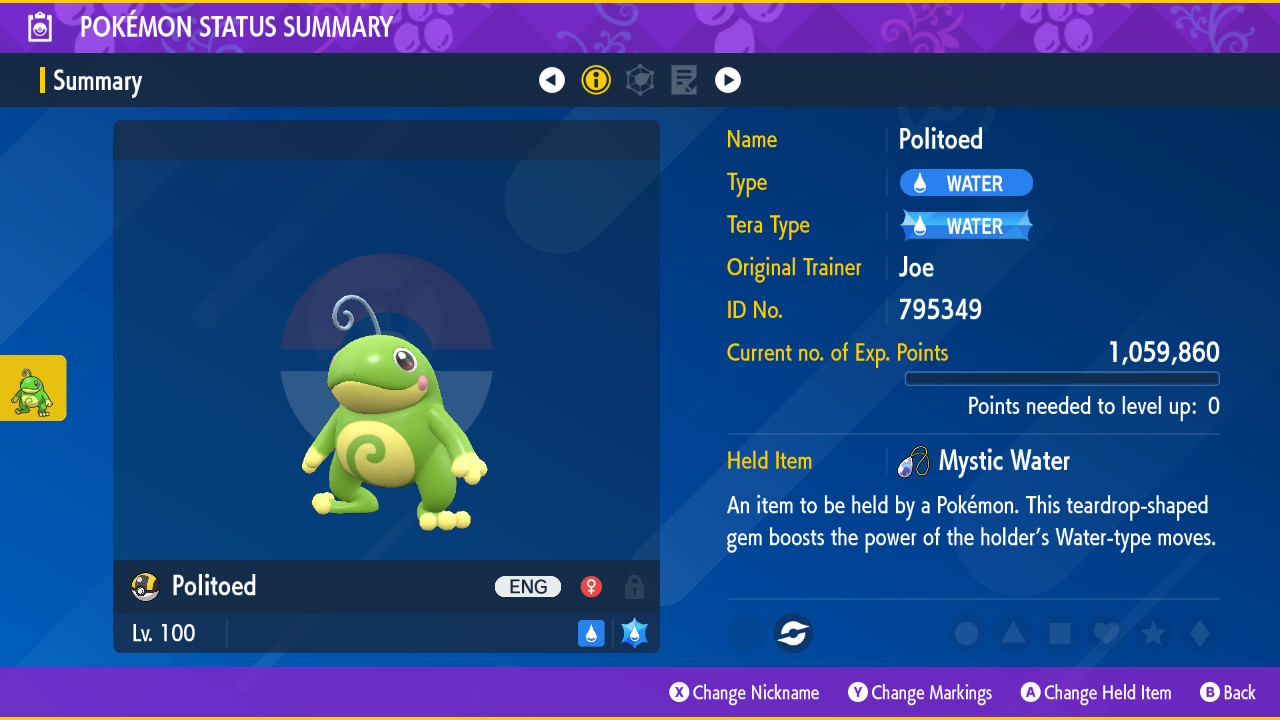
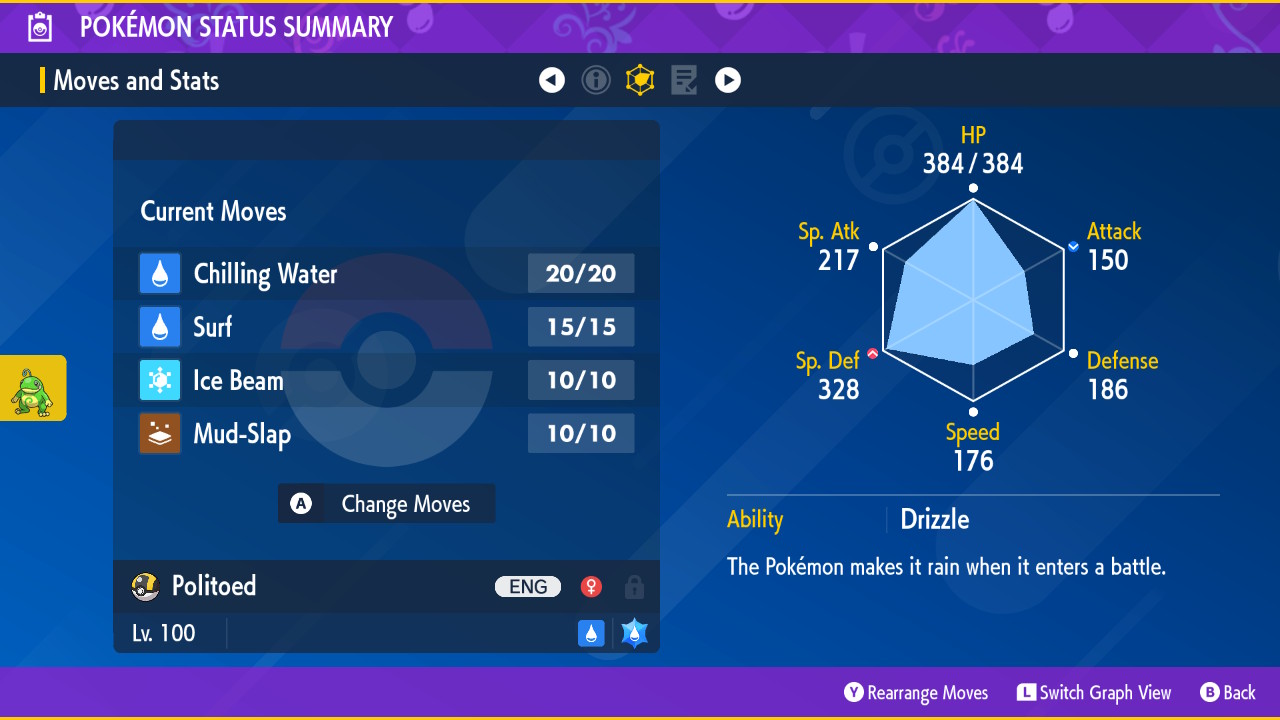
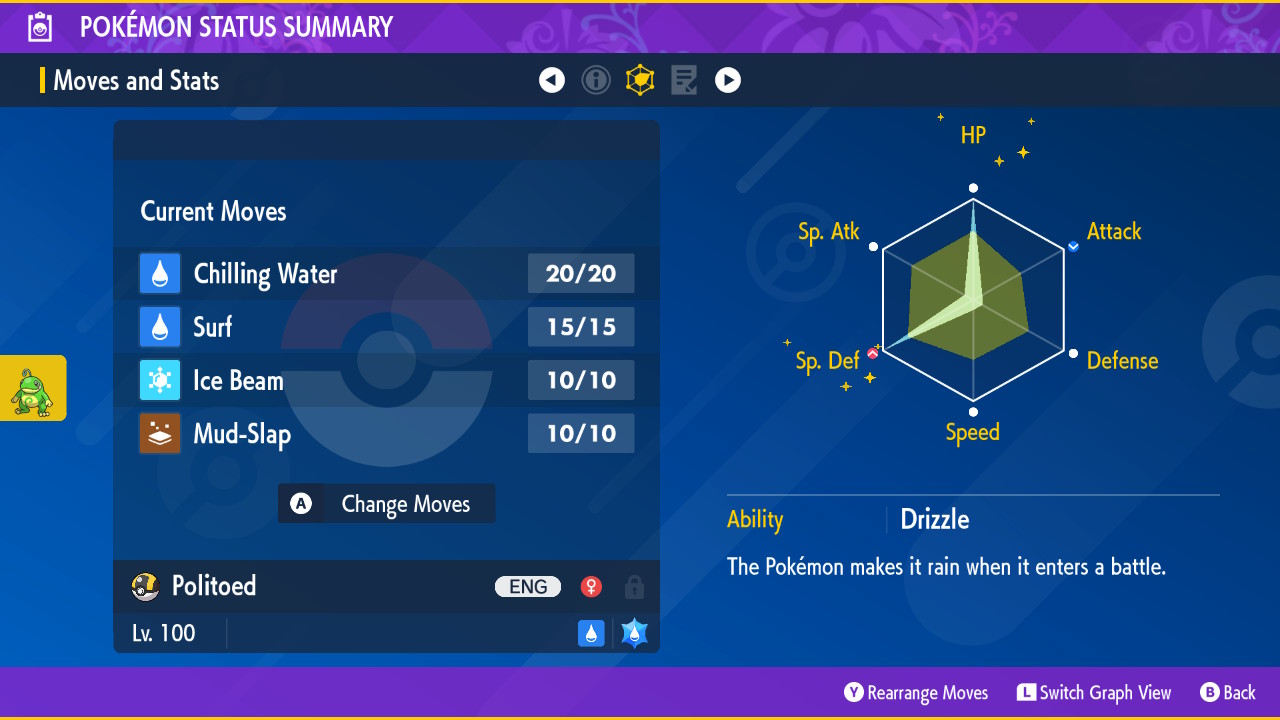
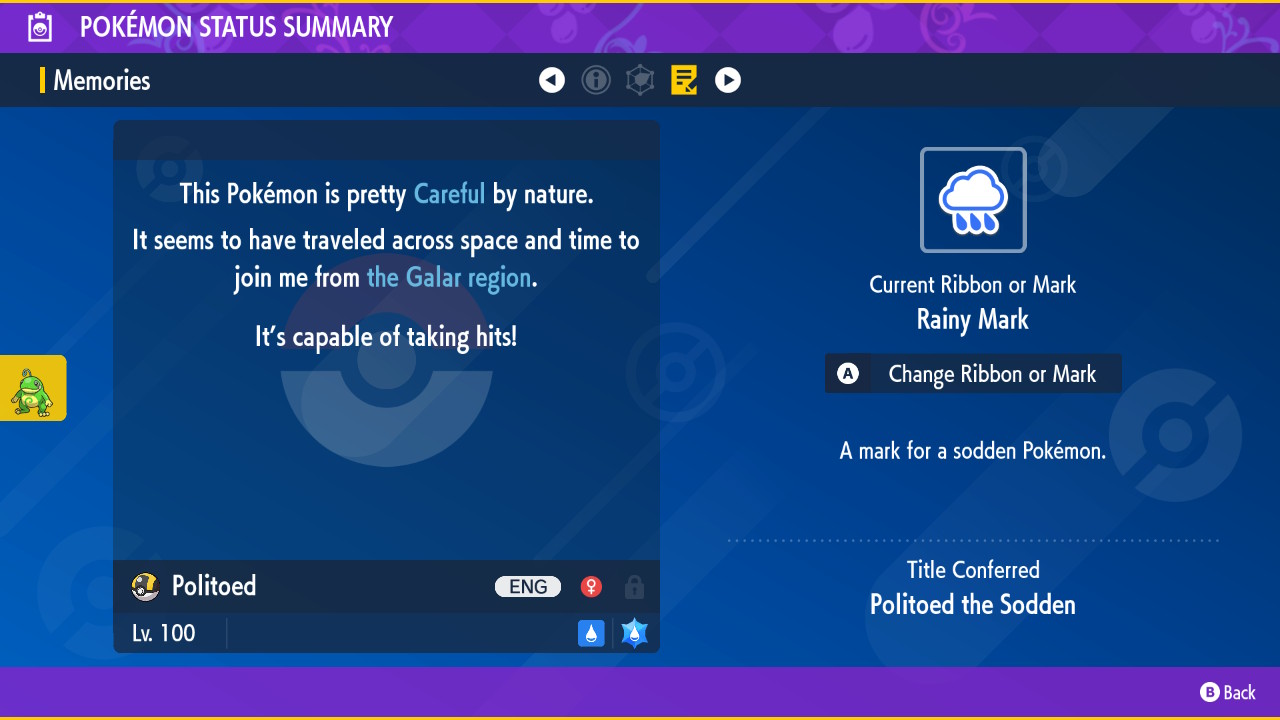
Mission accomplished! We successfully raised a raid-ready Politoed, and I hope you learned something interesting along the way.
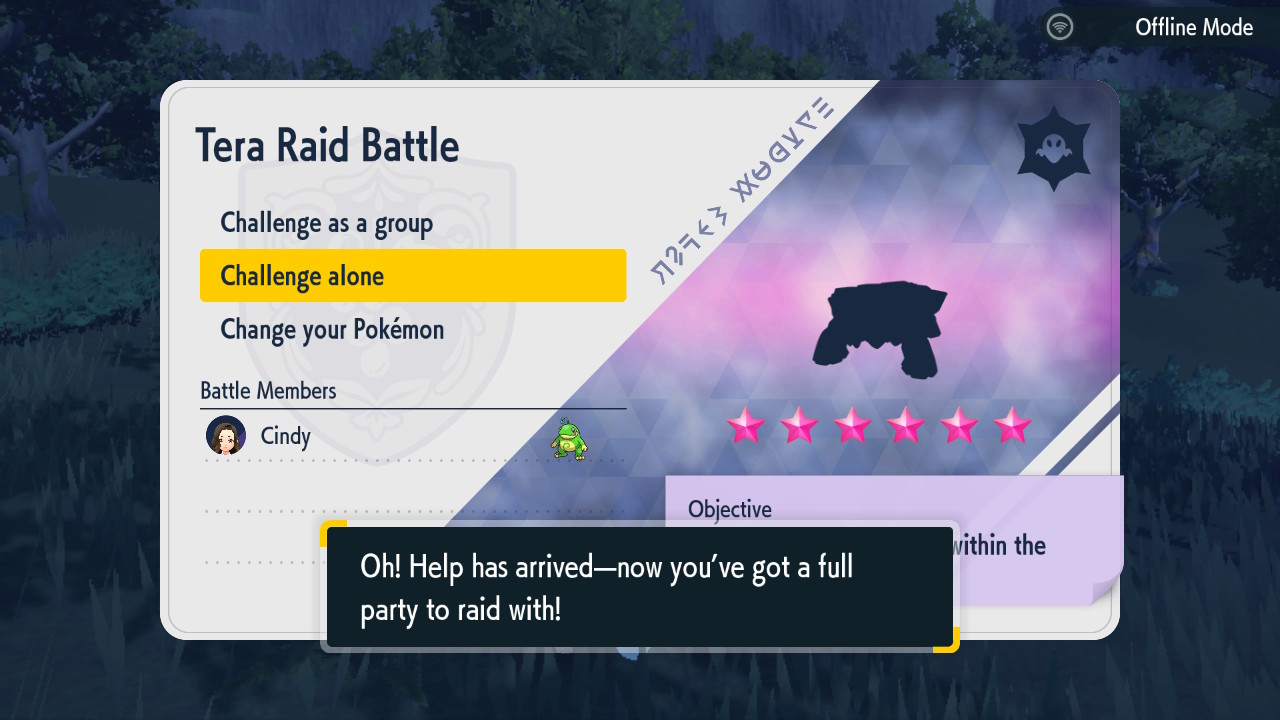
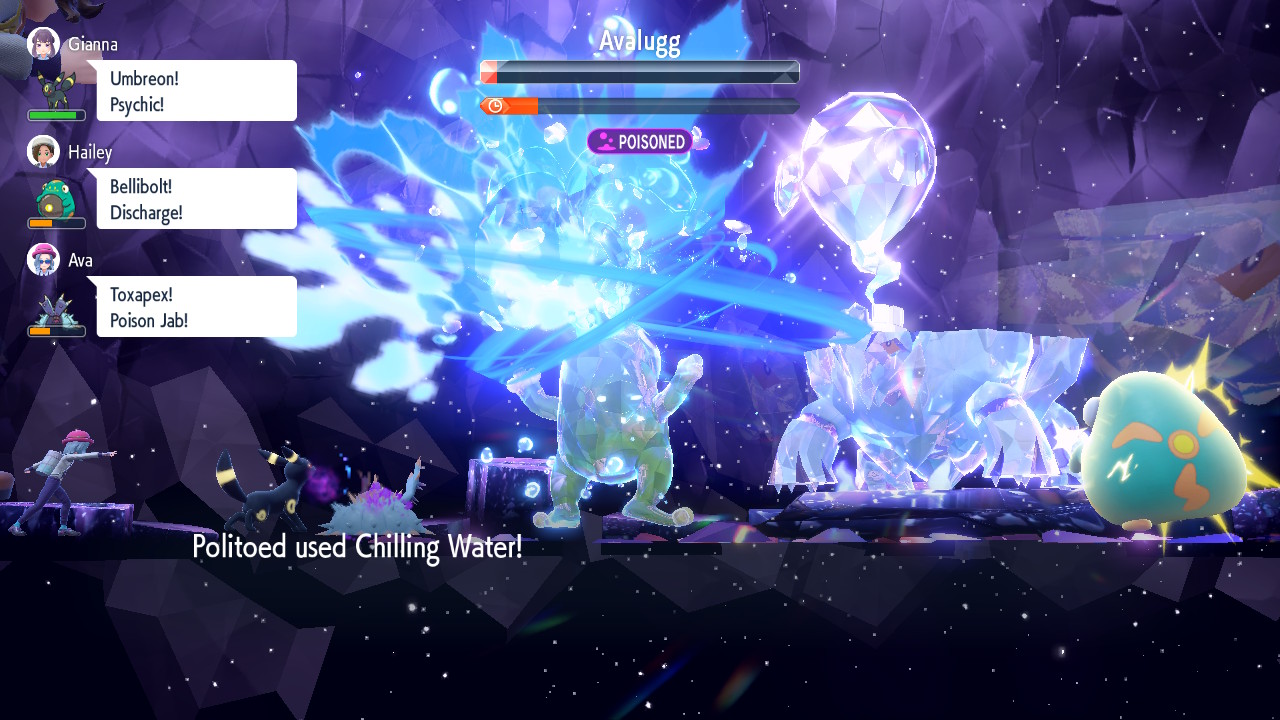

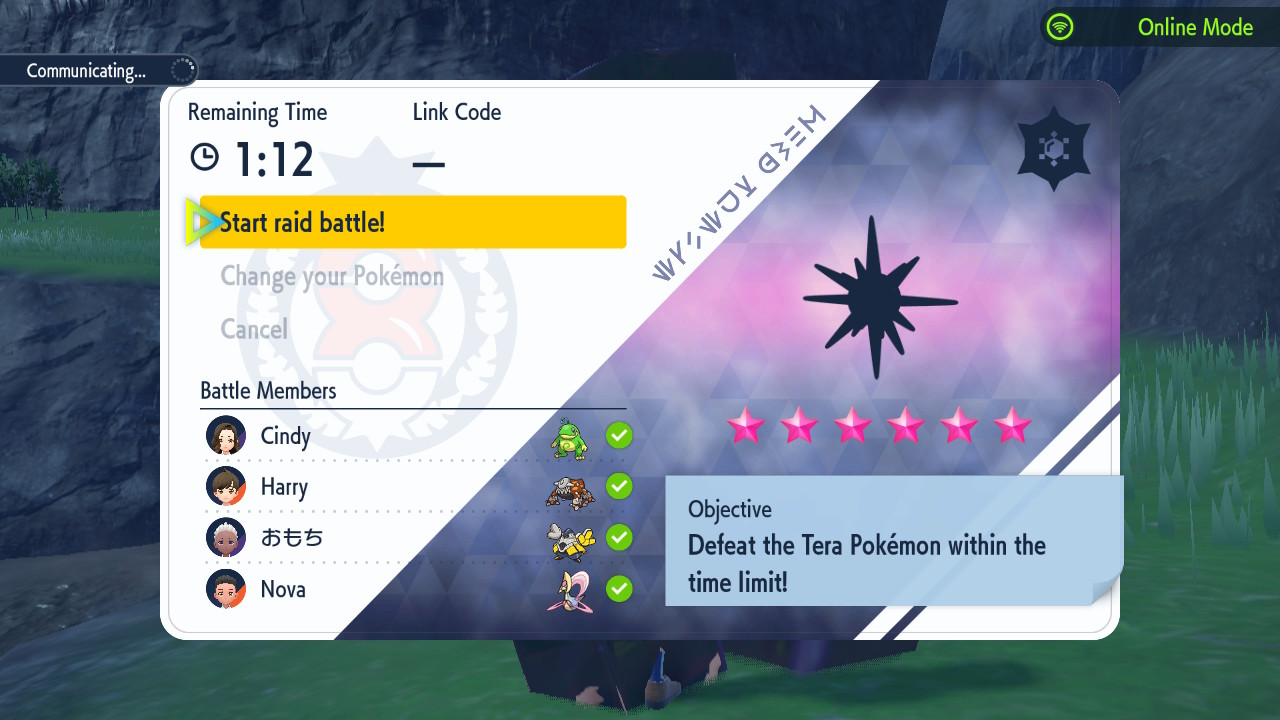
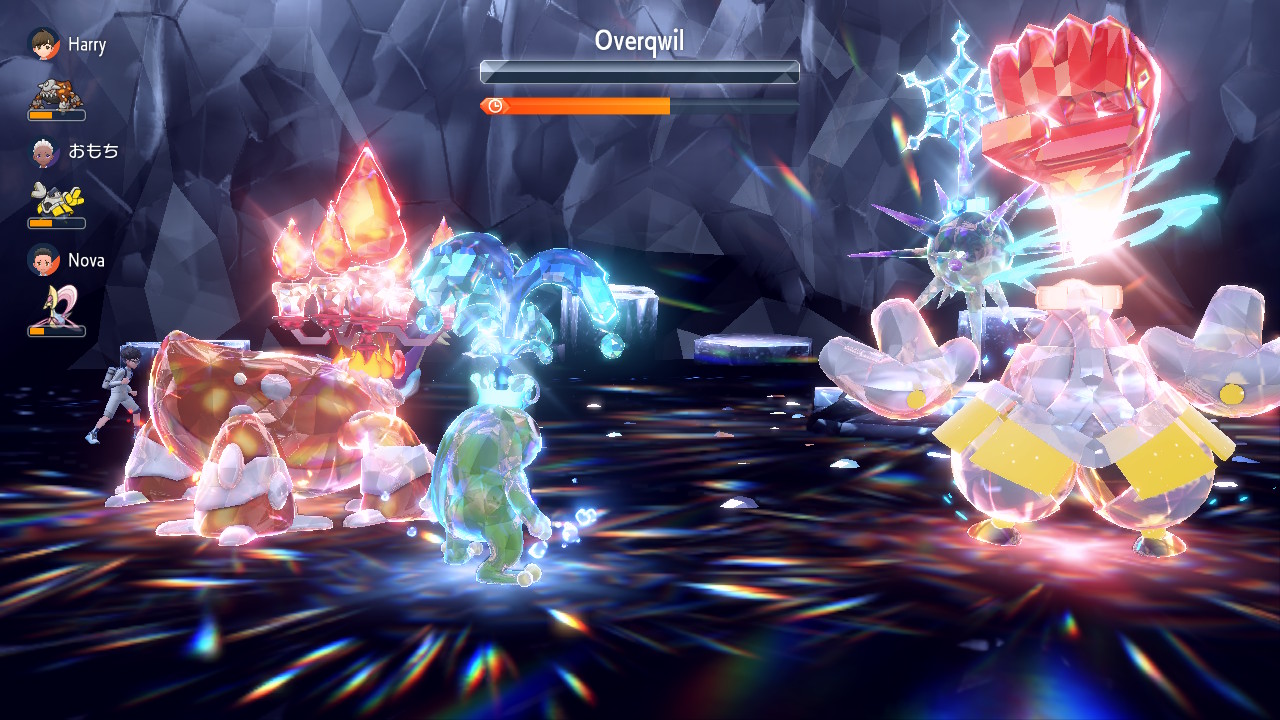
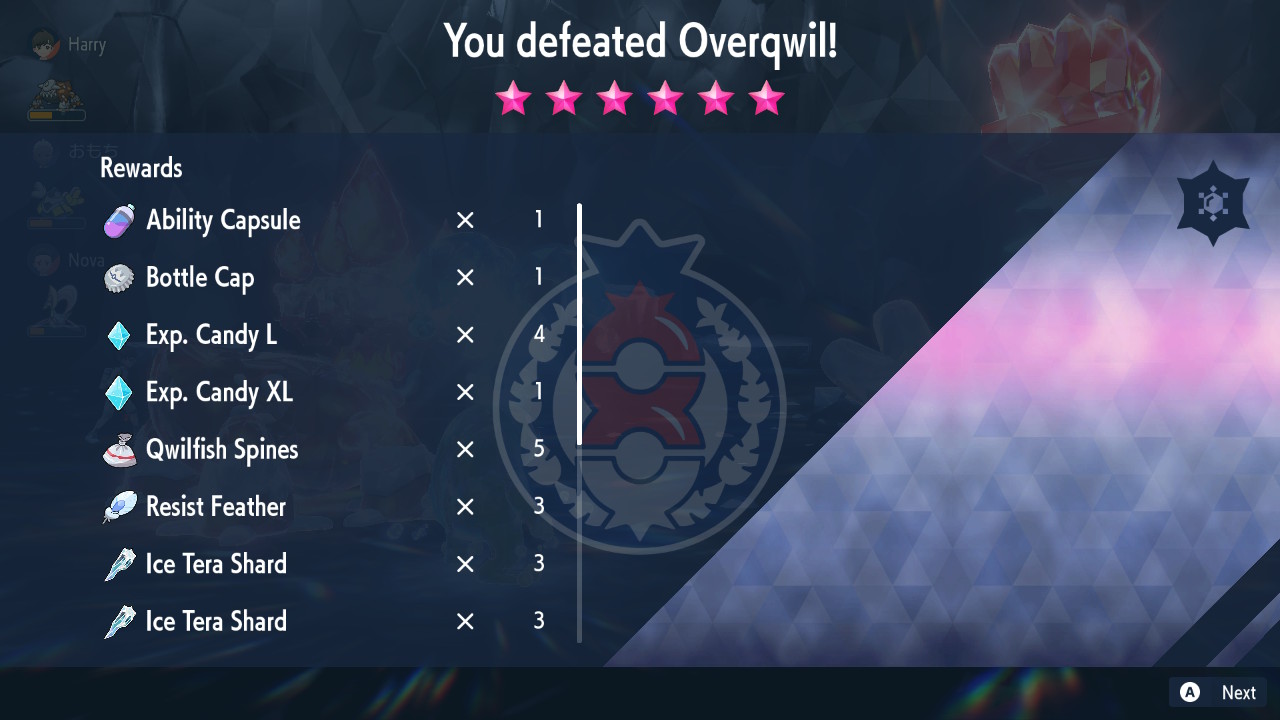

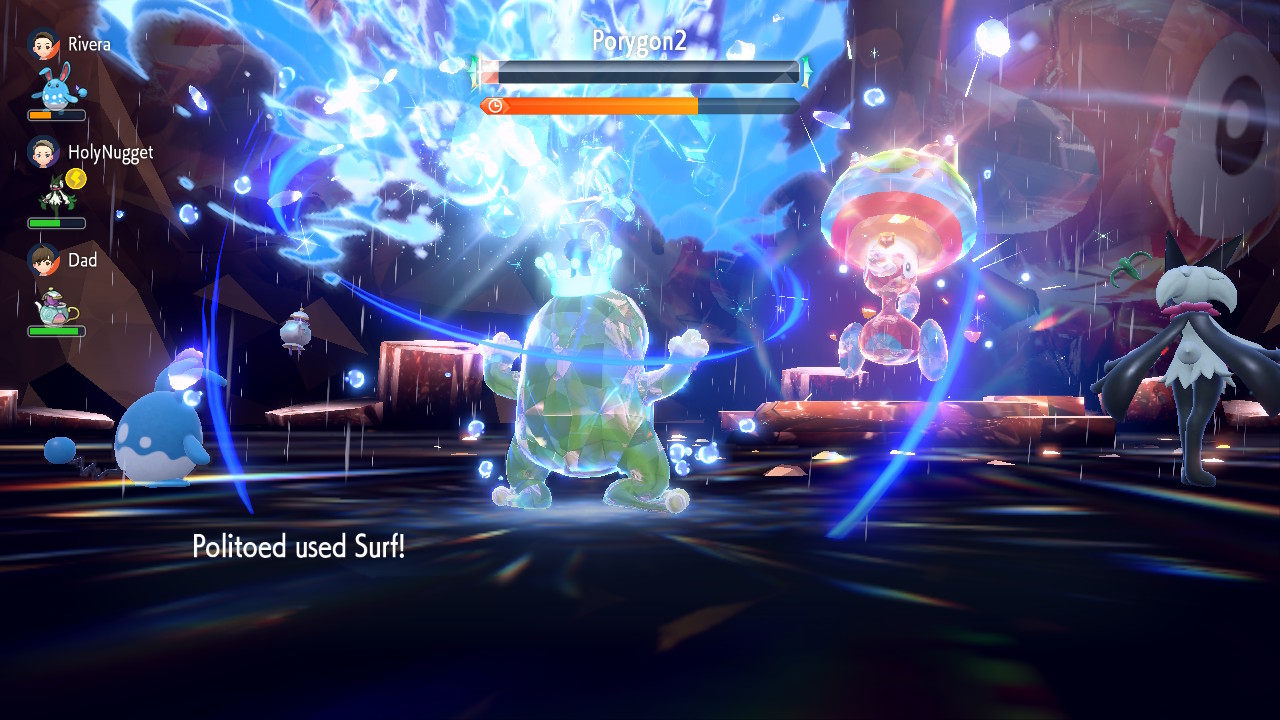

Train on!